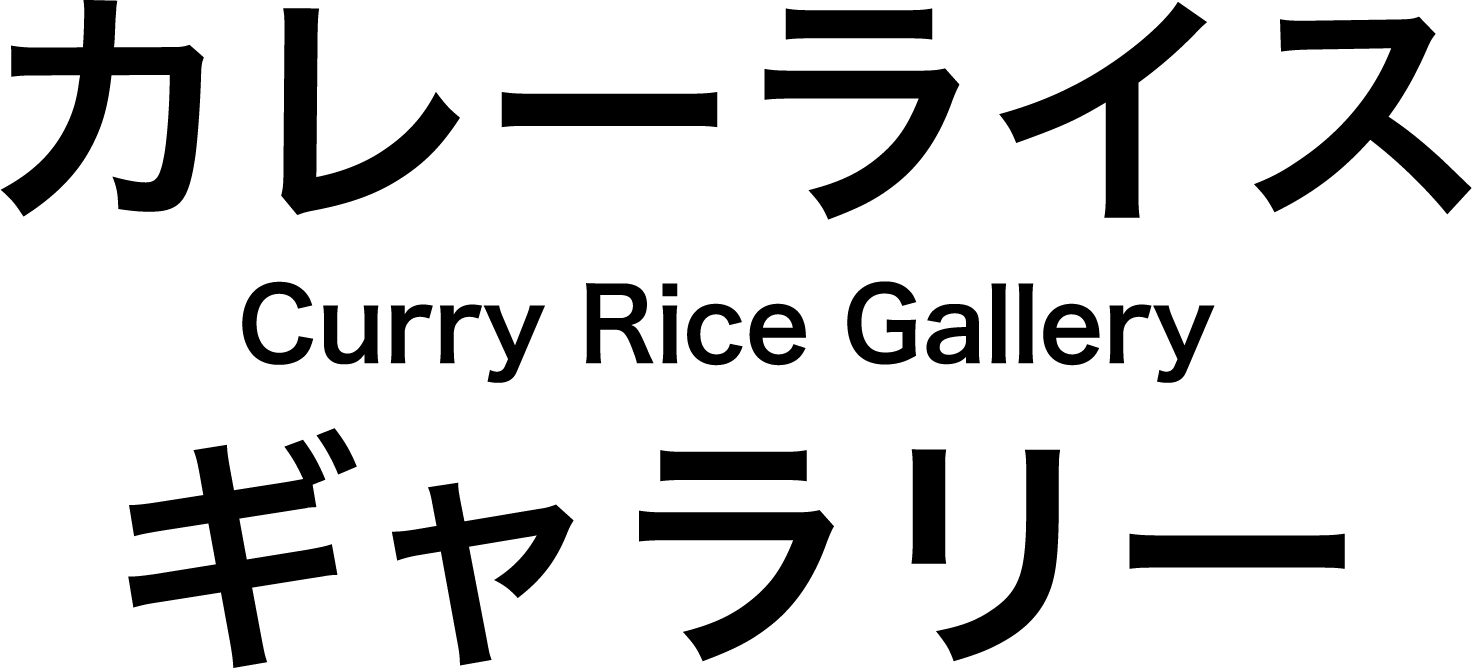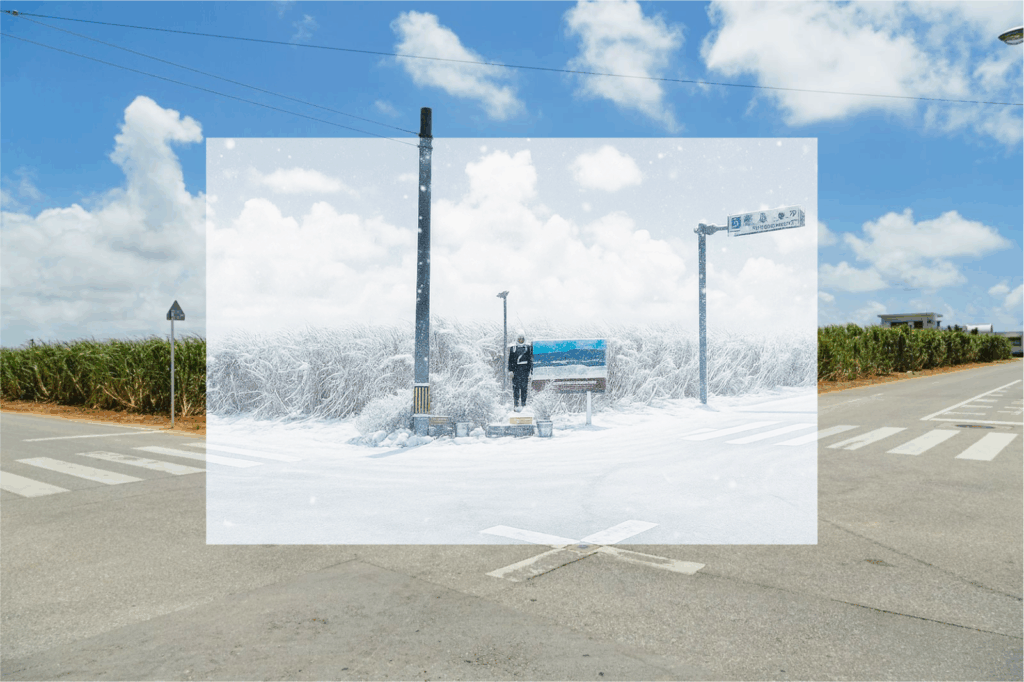
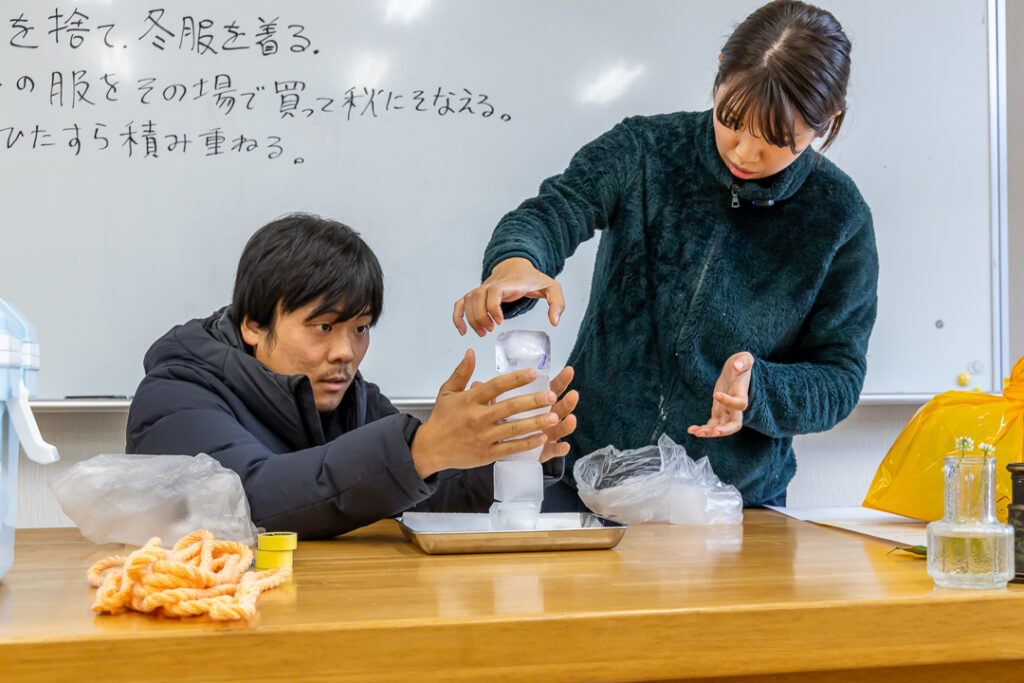
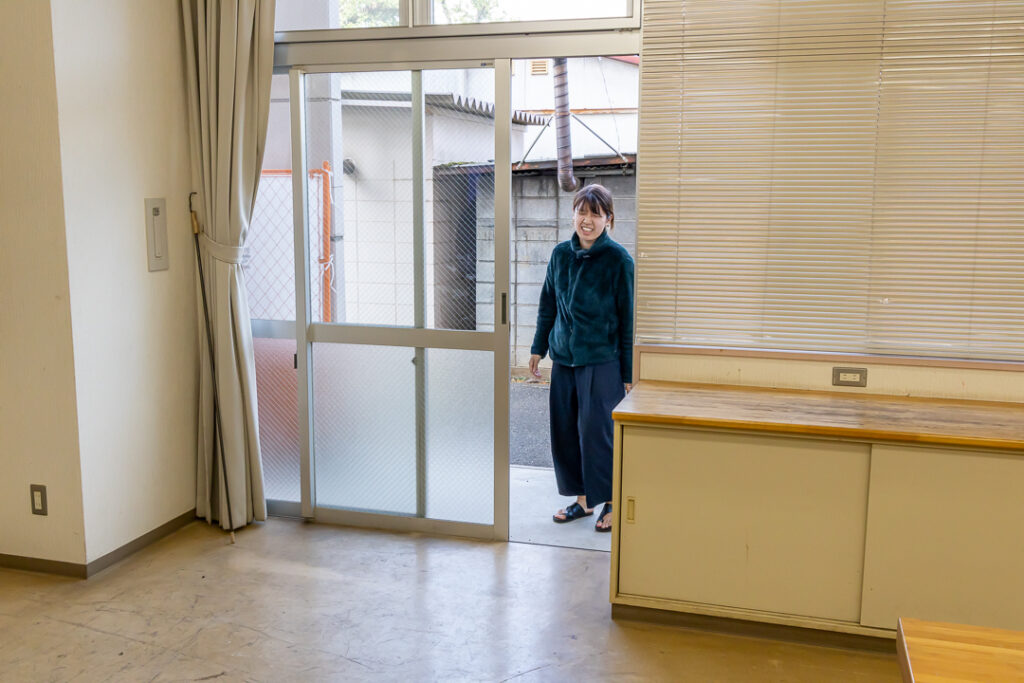
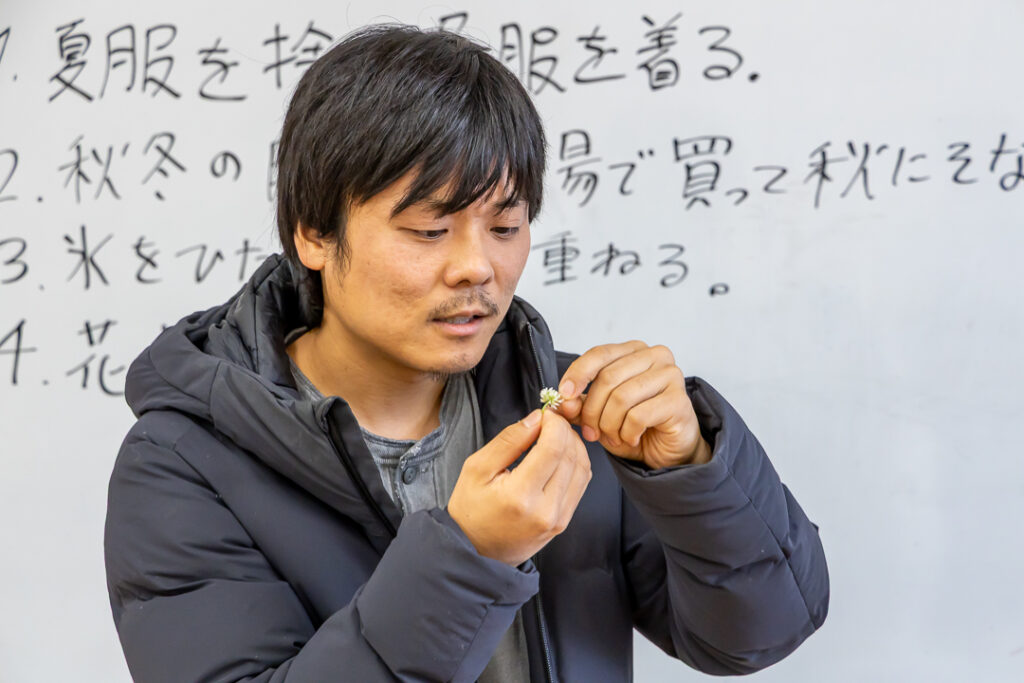
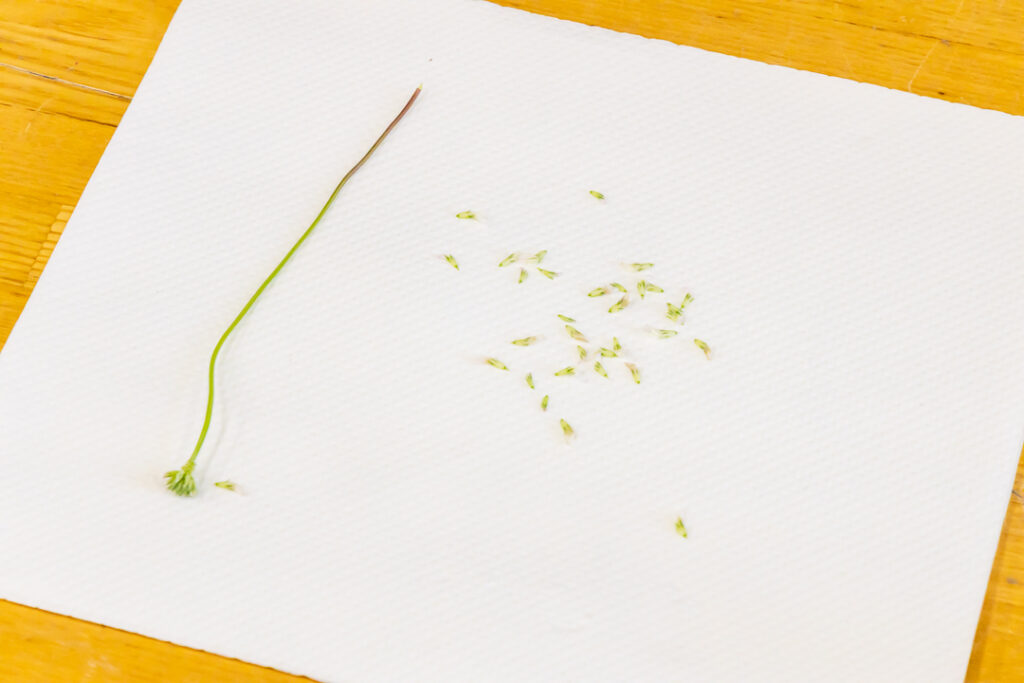
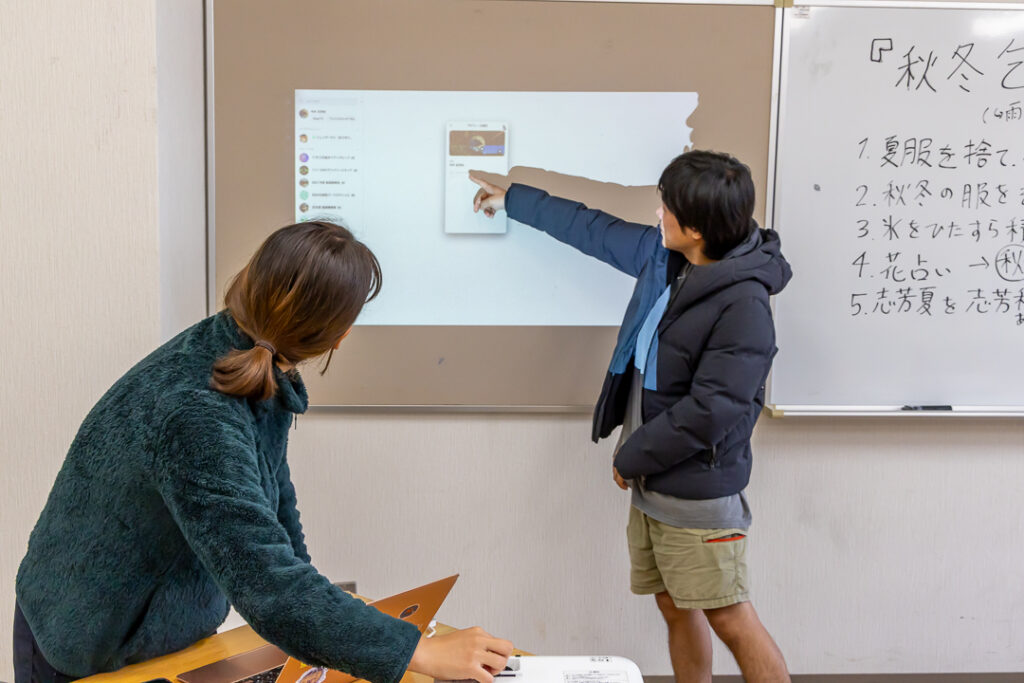
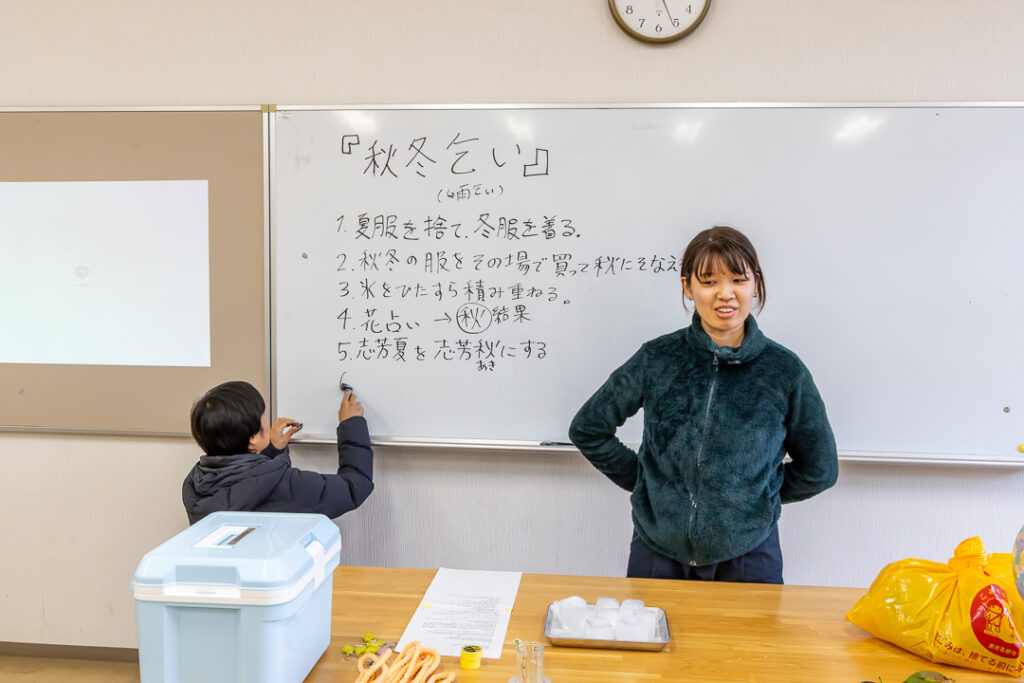
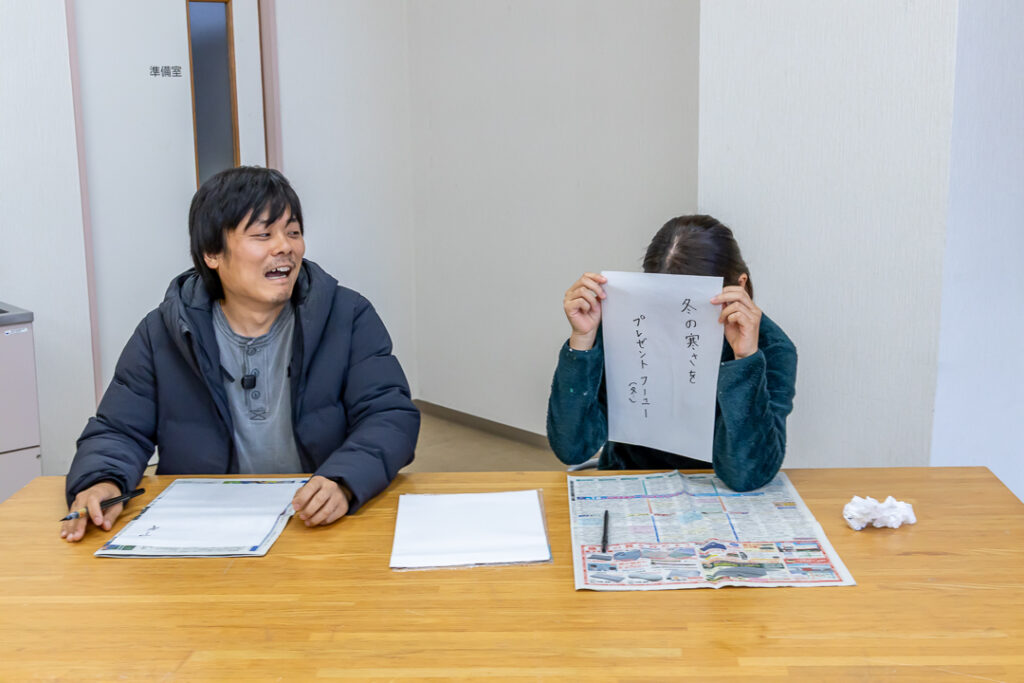
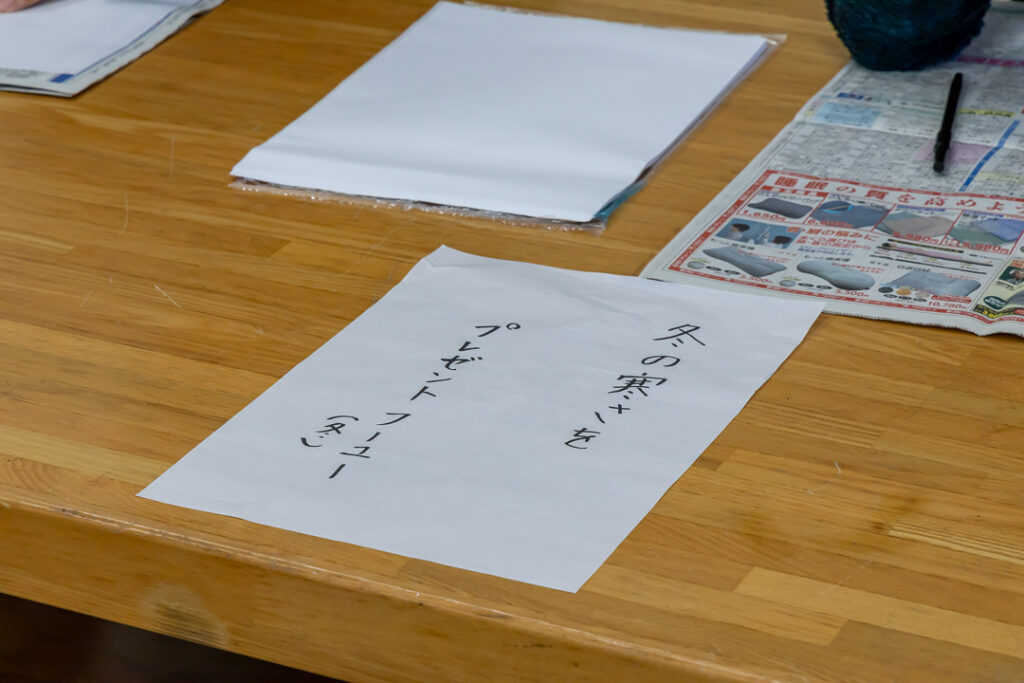
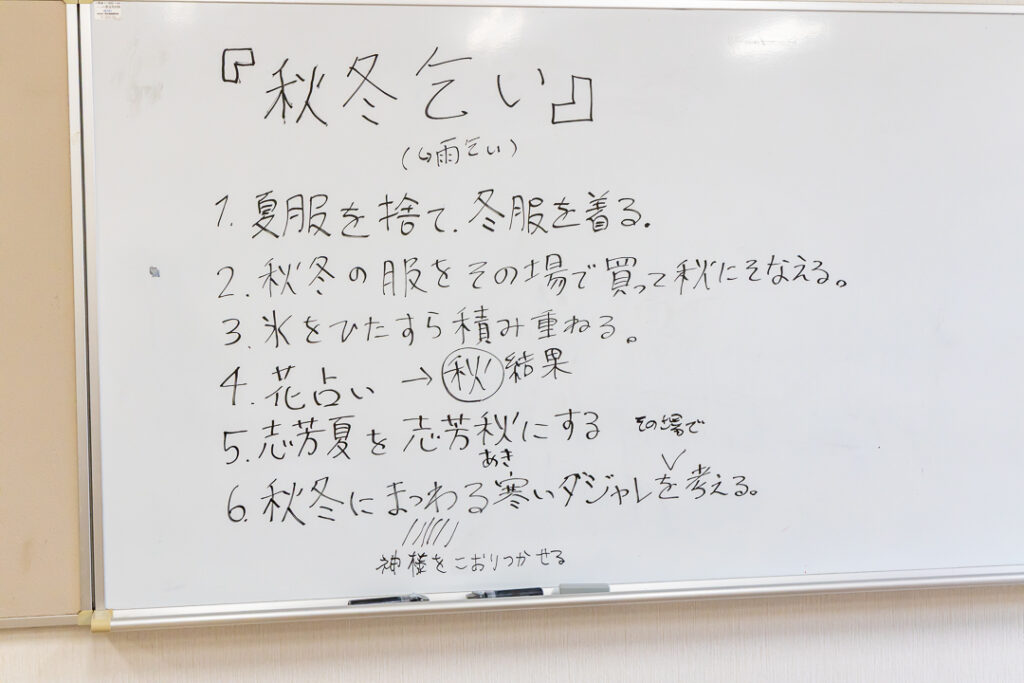
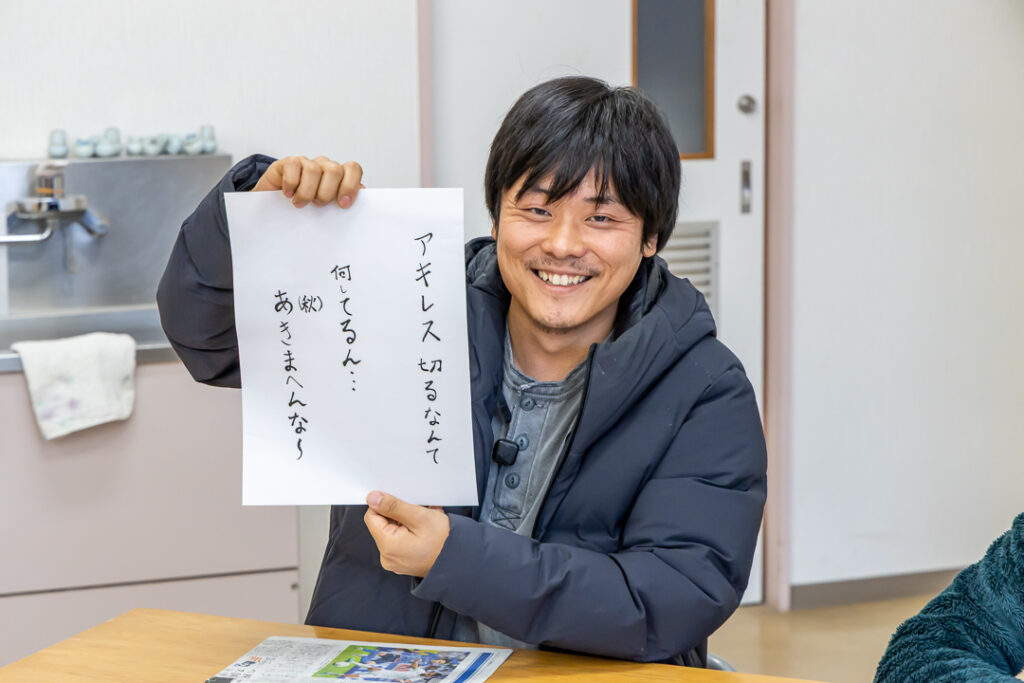
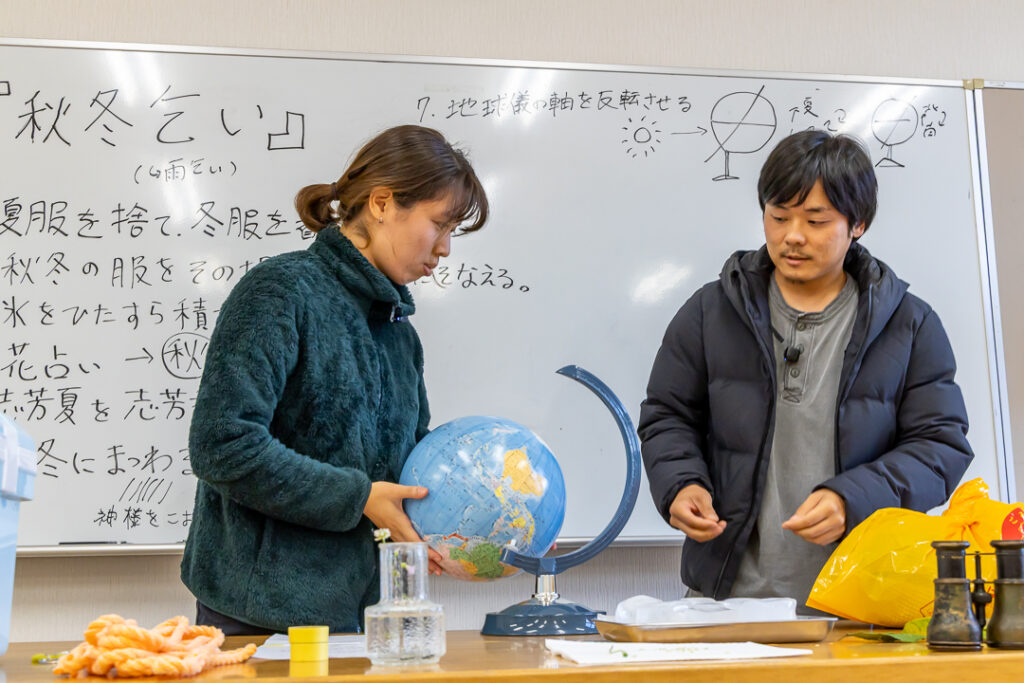
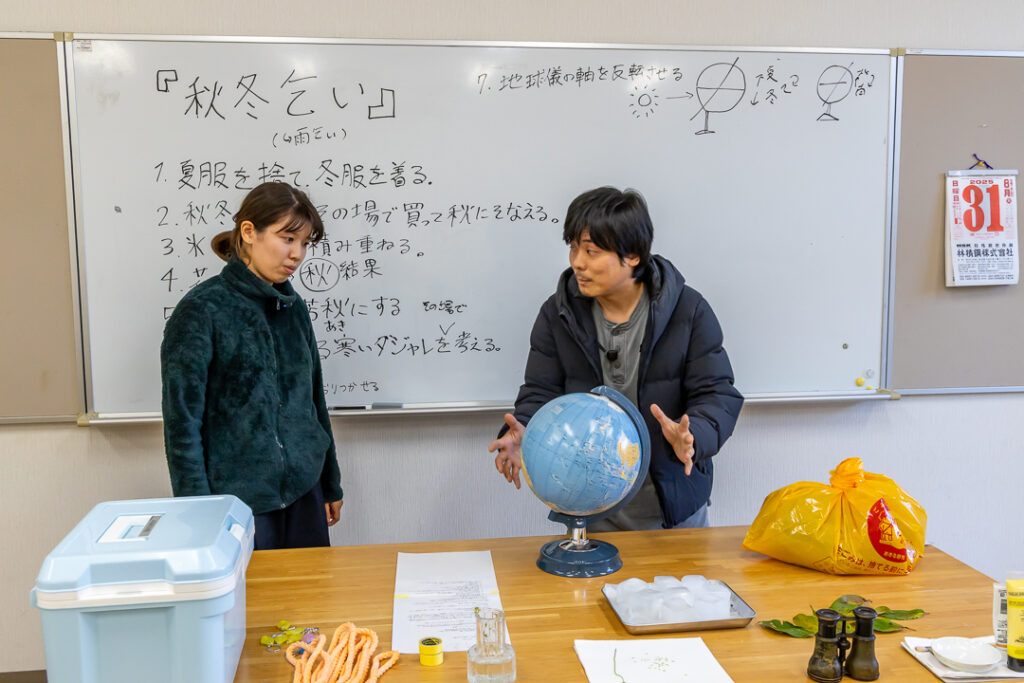
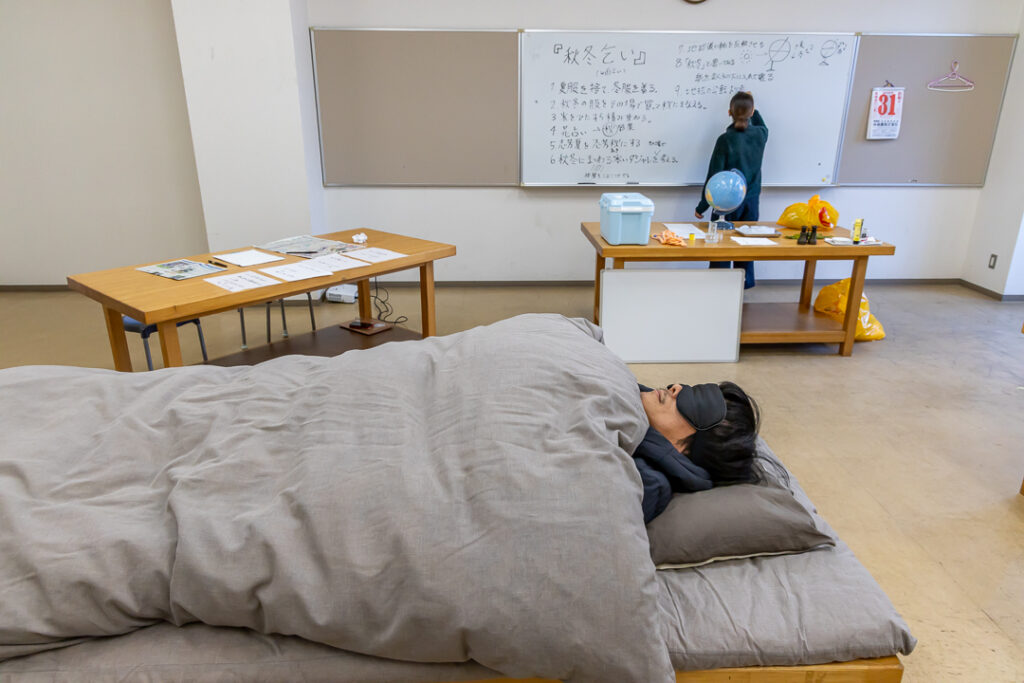
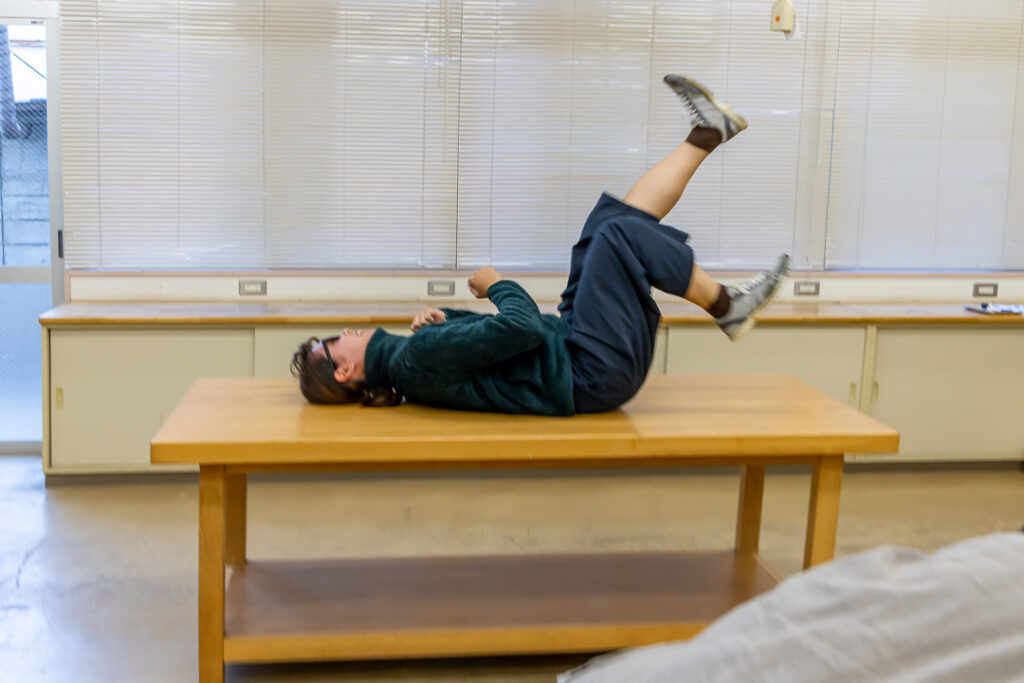
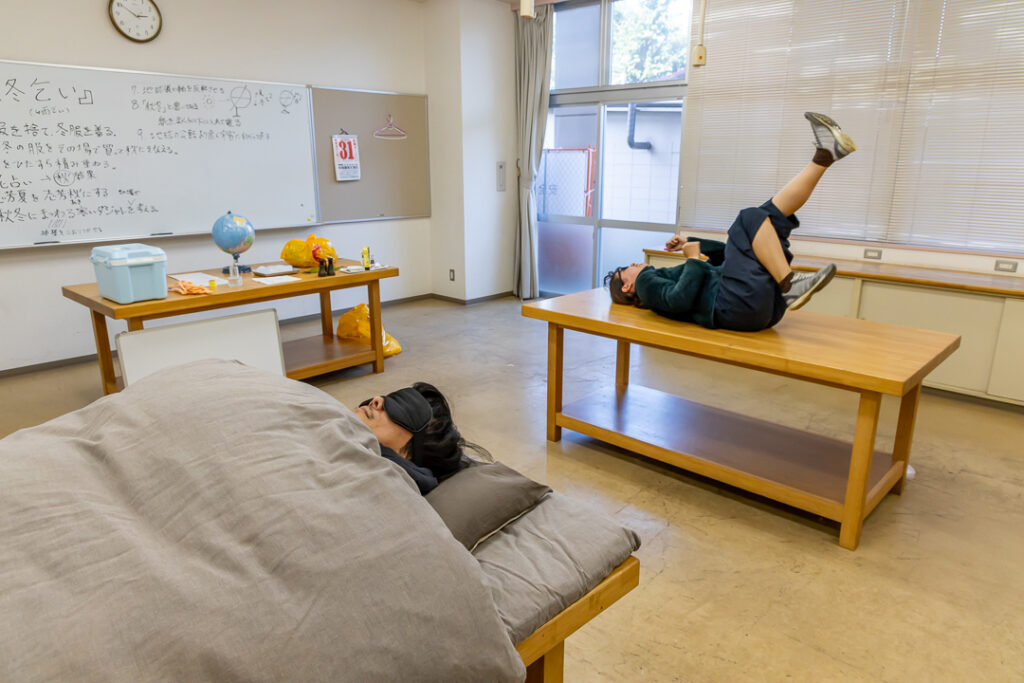
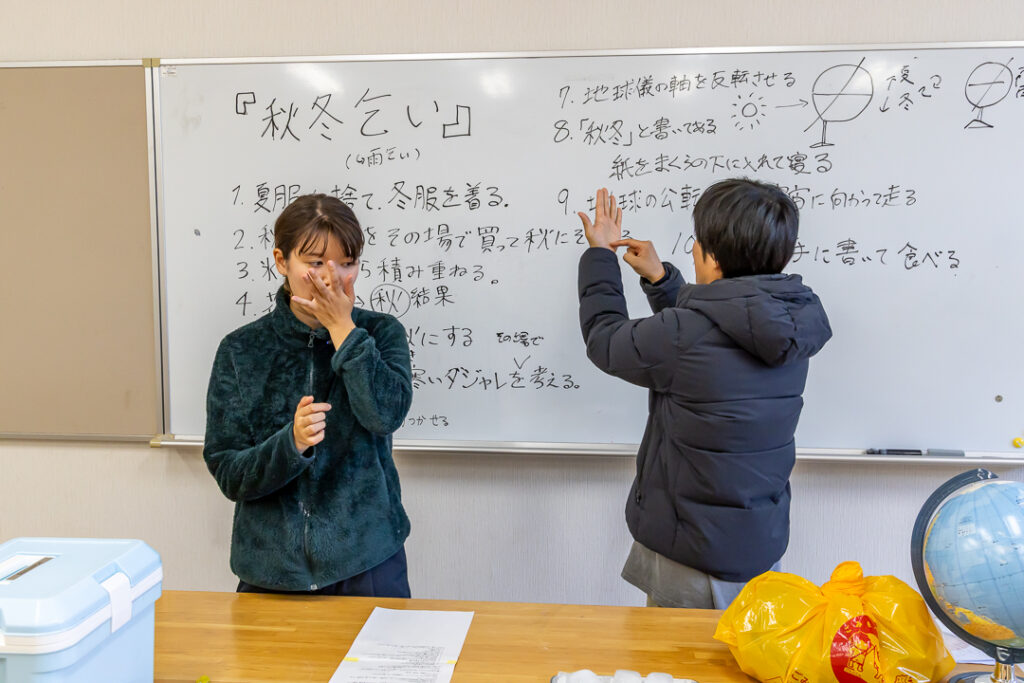
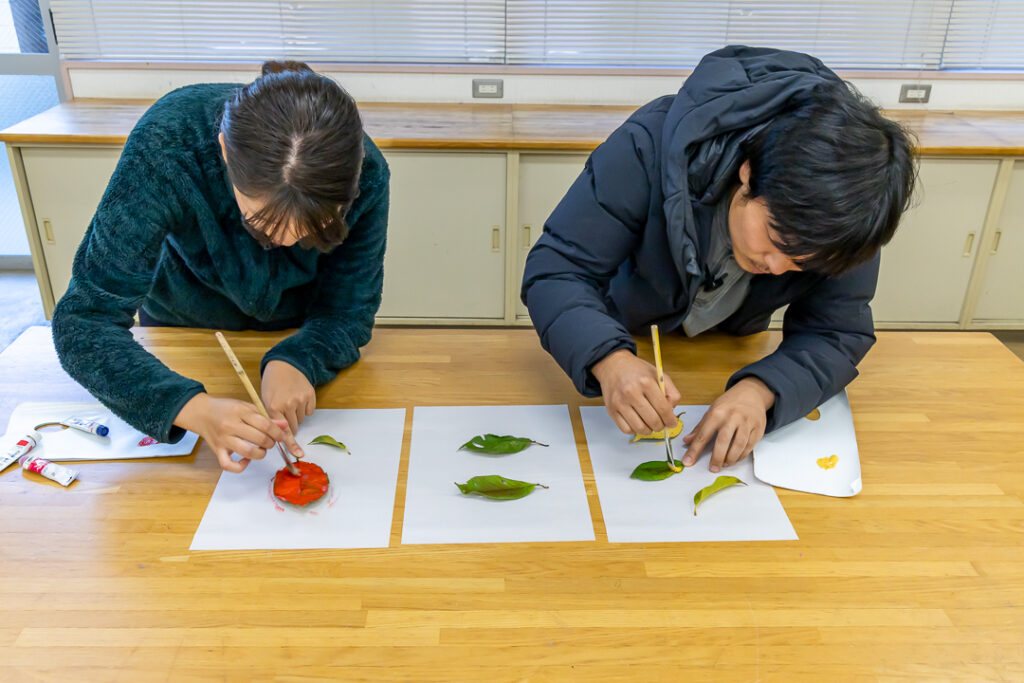
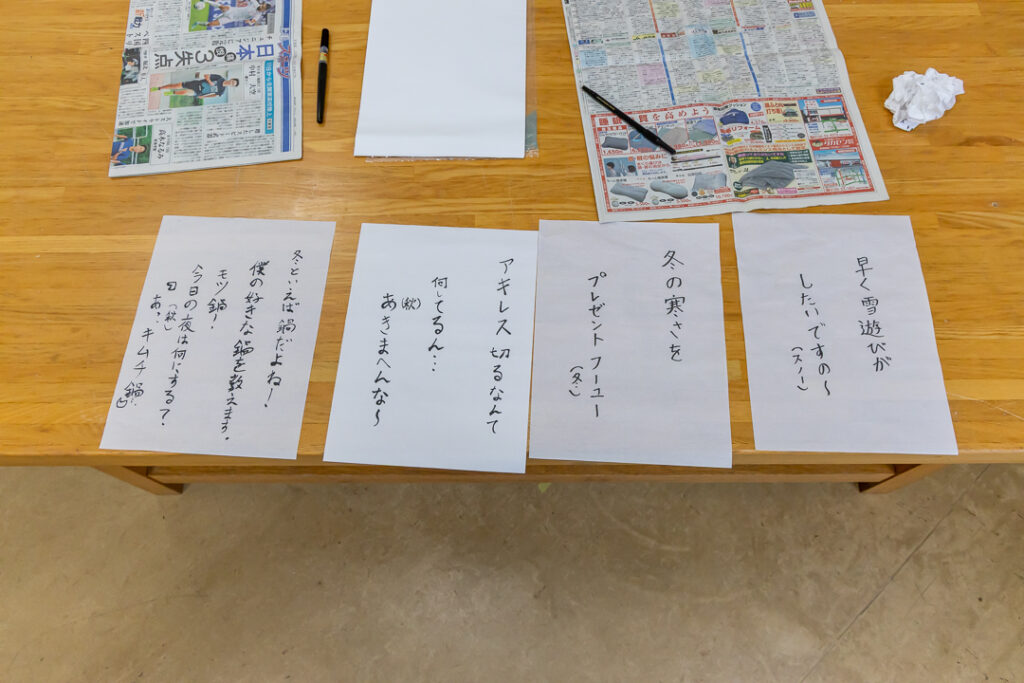
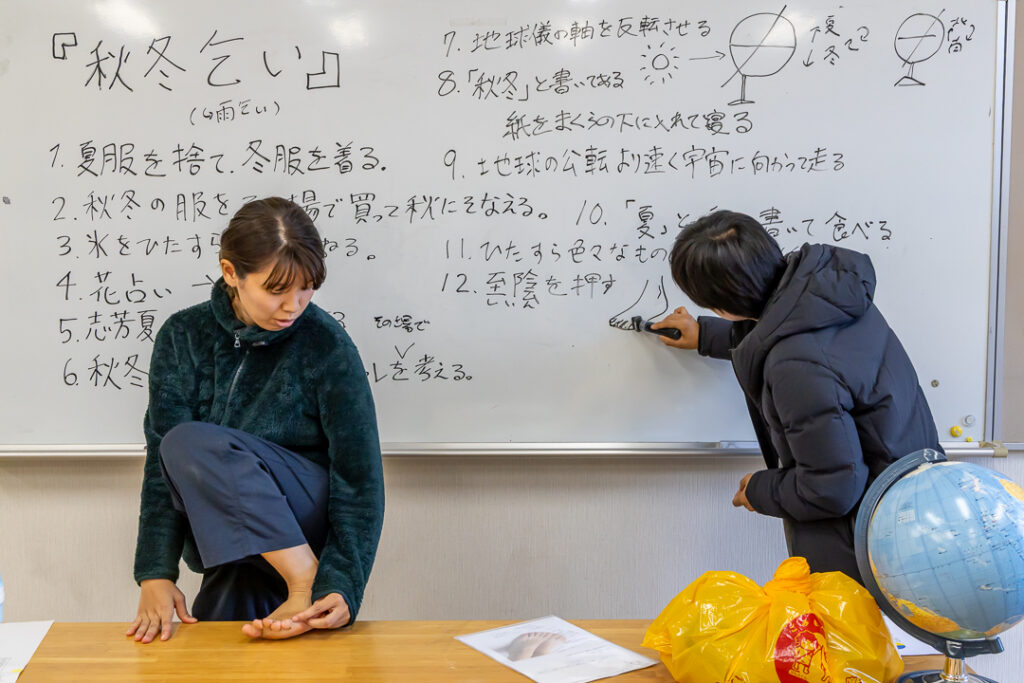
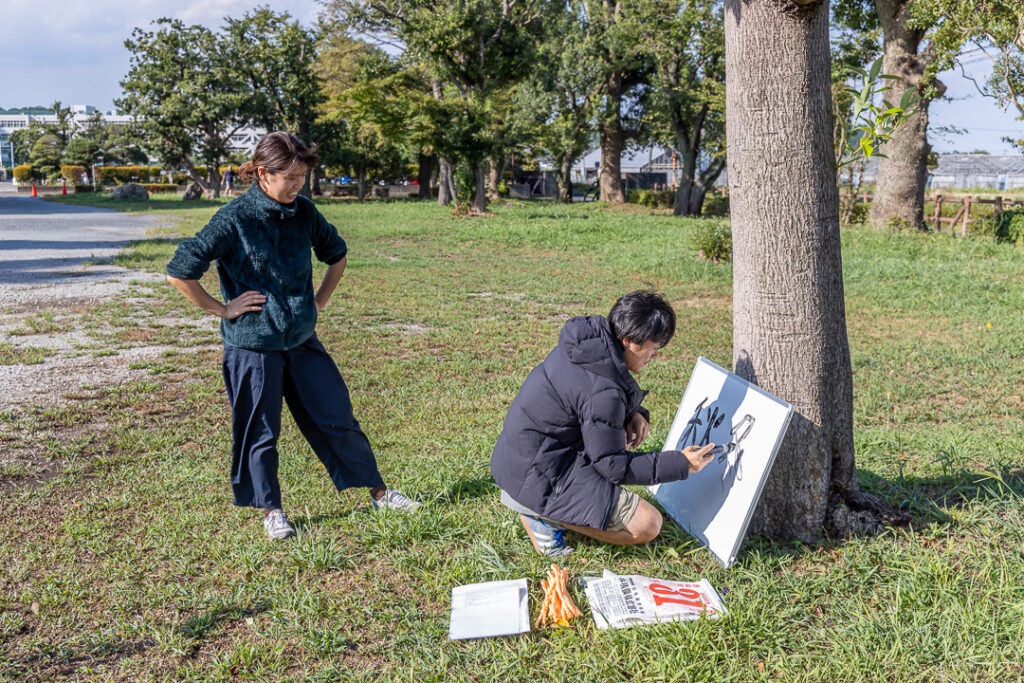
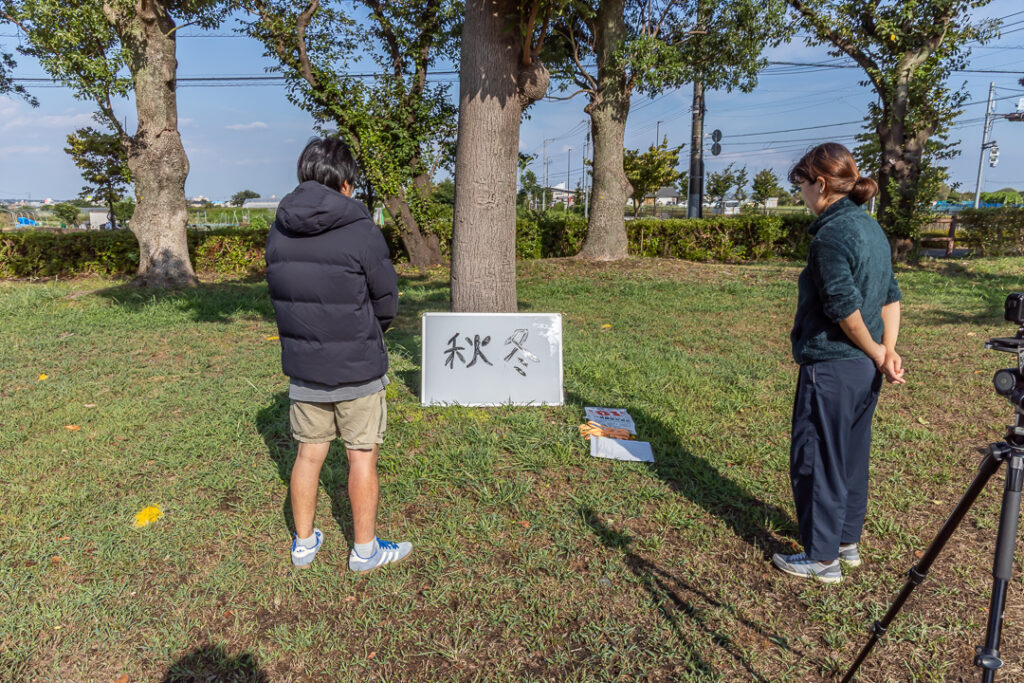
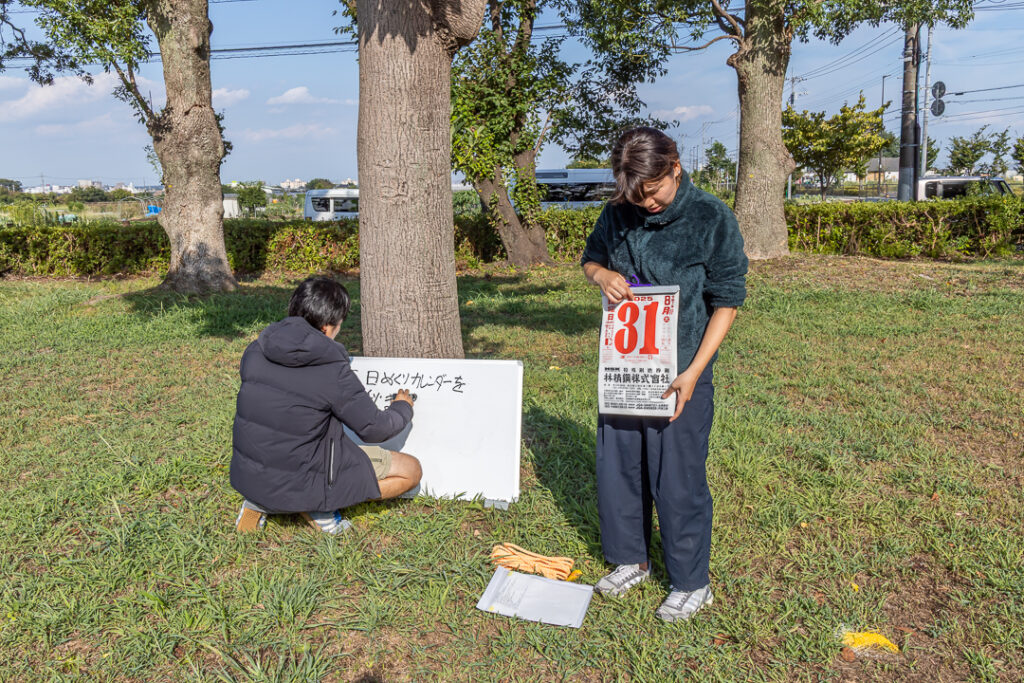
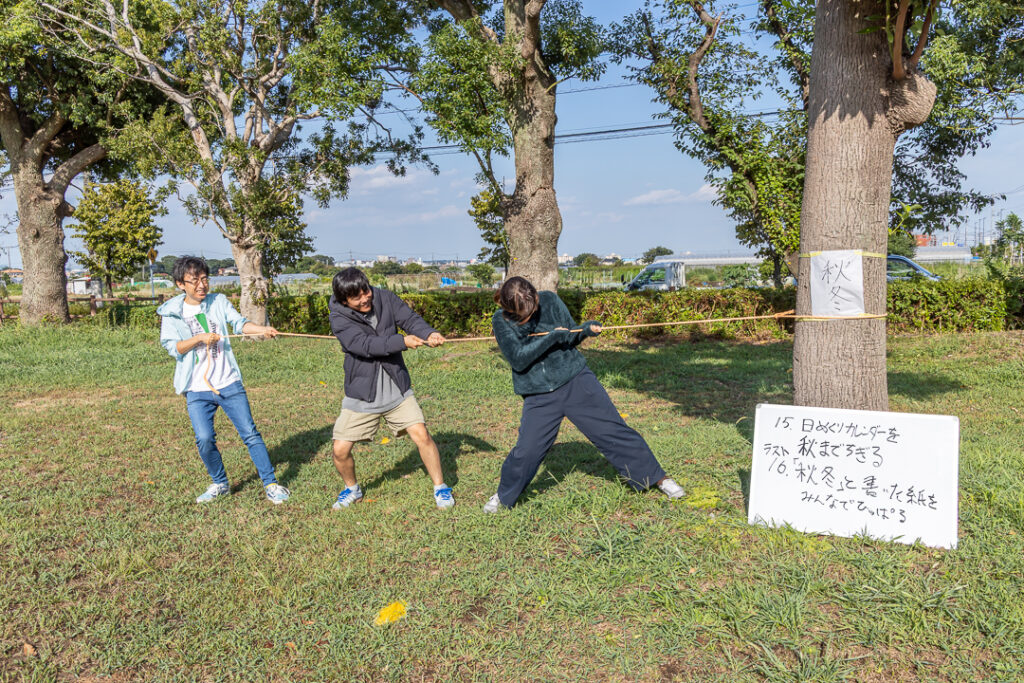
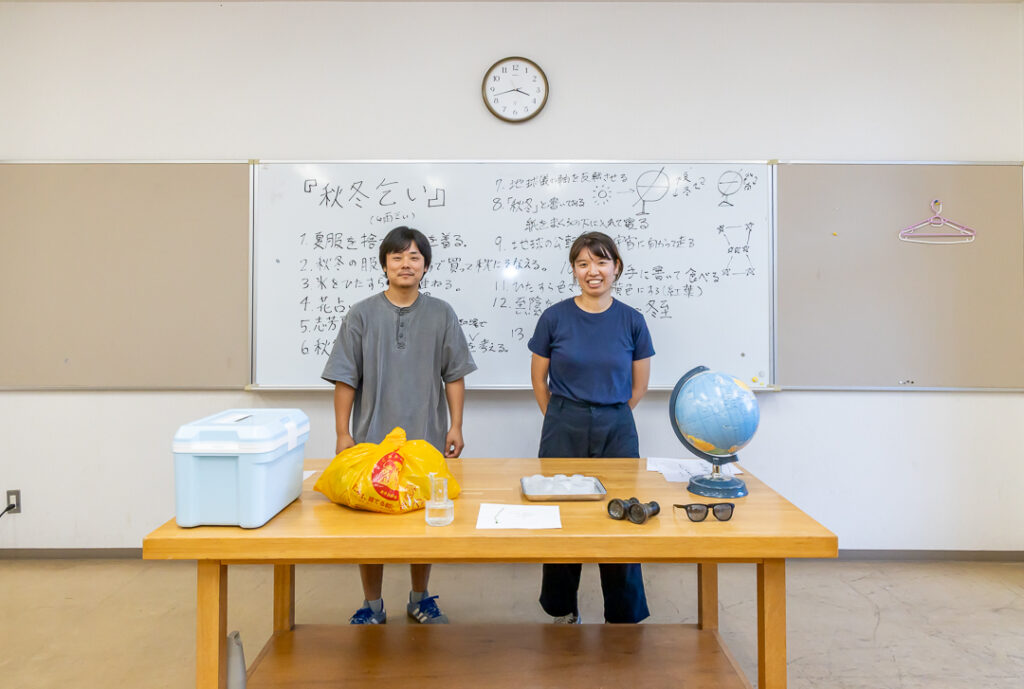
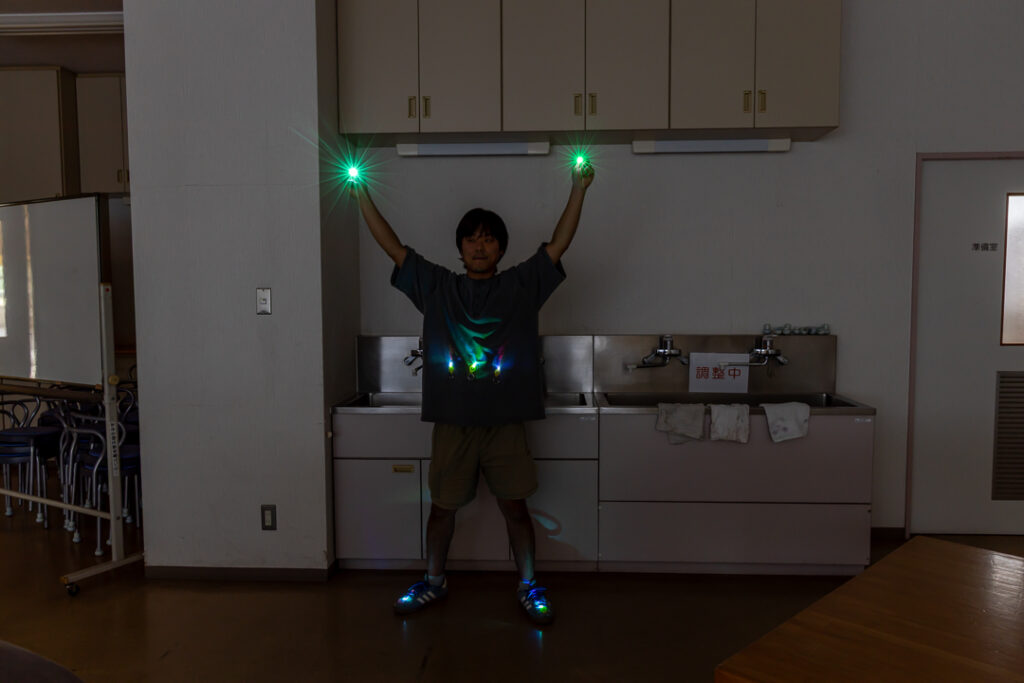
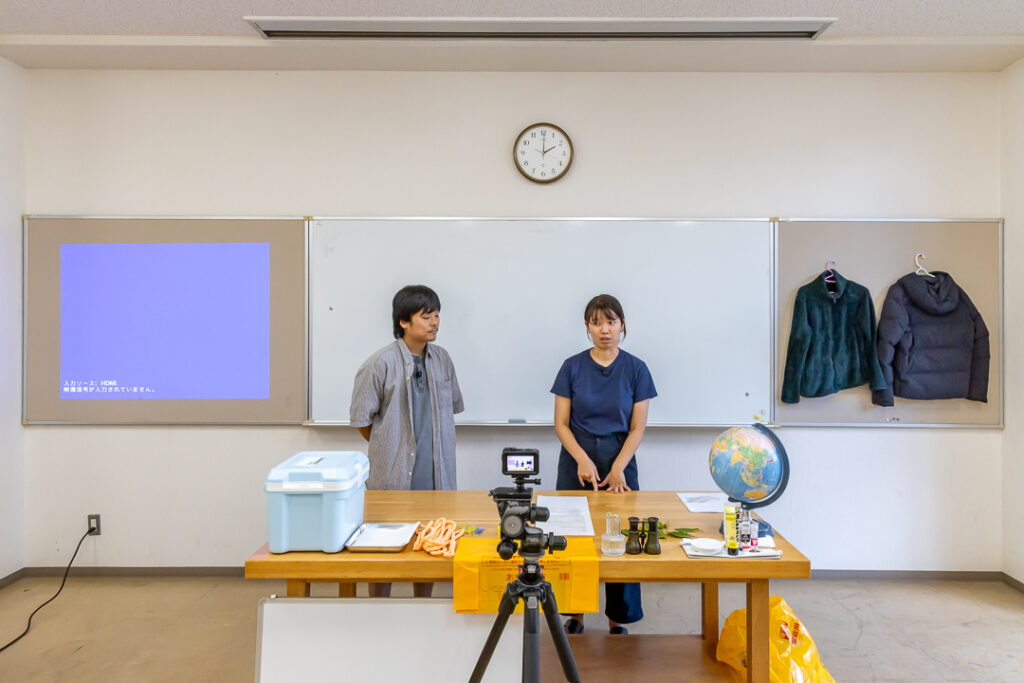
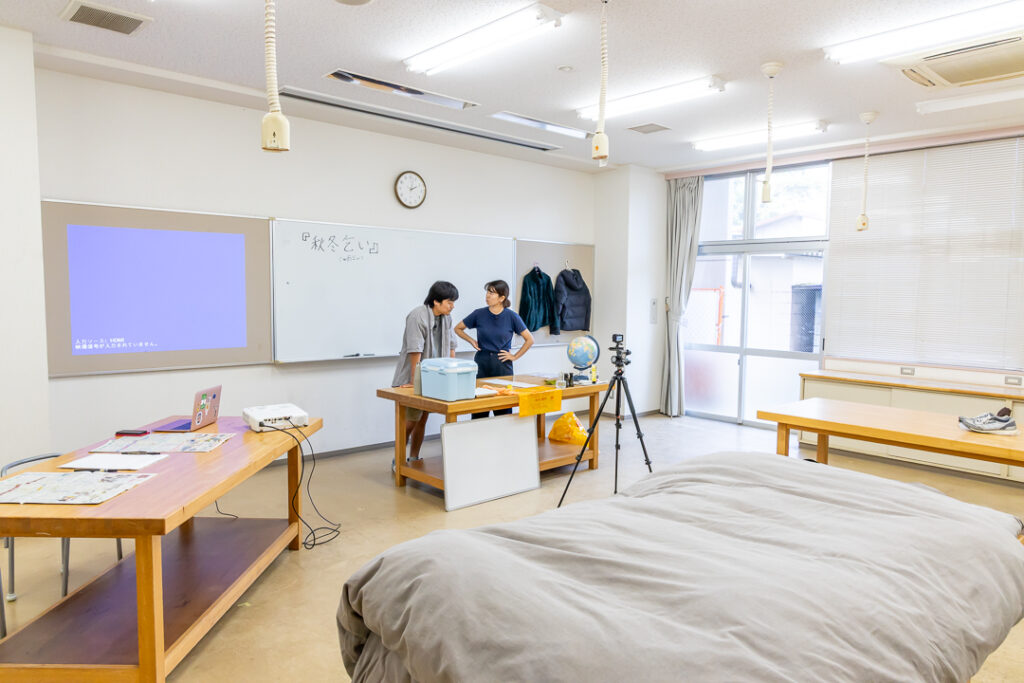
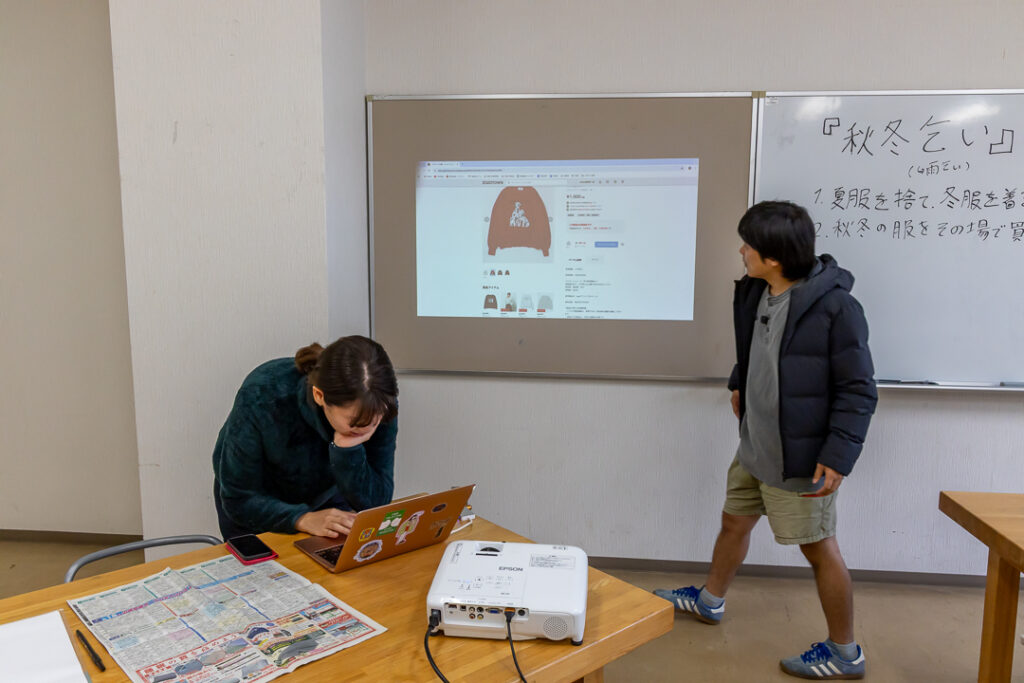
photo: 松尾宇人 Ujin Matsuo
ー
9月初旬、残暑は厳しい。果たして今年も秋冬はくるのだろうか。 まだ見ぬ今年の秋冬を乞う様々な方法をレクチャーする、実践的パフォーマンス。
ー
【秋冬乞いリスト】
1.夏服を捨て、冬服を着る。
2.秋冬の新作をその場で買って秋にそなえる。
3.氷をひたすら積み重ねる。
4.花占い(秋冬夏秋冬夏秋冬夏・・・)。
5.志芳夏を志芳秋にする(LINEプロフィール)。
6.秋冬にまつわる寒いダジャレをその場で考える。
7.地球儀の軸を反転させる。
8.「秋冬」と書いてある紙を枕の下に入れて寝る。
9.地球の公転より速く宇宙に向かって走る。
10.「夏」と手に書いて食べる。
11.木の葉を黄色にする(紅葉させる)。
12.至陰(しいん)を押す(足のツボ)。
13.オリオン座を作る。
14.「秋冬」を影送りする。
15.日めくりカレンダーを秋までちぎる。
16.「秋冬」と書いた紙を皆で引っ張る。
ー
「秋冬乞い」
日時:2025年9月6日
会場:あきる野市中央公民館
作家:今井しほか+大石一貴
ー
今井しほか+大石一貴
2023年から活動するアーティストの今井しほかと彫刻家の大石一貴のユニット。2023年「光を測る」展示(東京/電気神殿メタコイノン)、2024年イベント「影を描く、影を送る」(横浜市内)。
ー
レビュー『秋燈を明うせよ秋燈を明うせよ ―― 今井しほか+大石一貴「秋冬乞い」に寄せて』平岡希望
秋灯とは「秋の夜の灯火」を意味する季語らしい〈注1〉。しかし私が、星野立子の句〈注2〉からイメージしたのは点々と灯っていく秋のはじまりを告げるシグナルで、二十四節気ならば、まさに「処暑」から「白露」に移り変わろうという9月6日〈注3〉の昼過ぎ、黒緑のフリースを着て早々に衣替えした今井しほかさんは一歩外に出た。「まだ暑い。」と振り返った室内には、同じく黒いダウンを羽織った大石一貴さんがいて、今井さんは部屋に戻ると引き戸を閉めた。
あきる野市中央公民館1階奥の、教室みたいな「第2工作室」。その壁面ホワイトボードには「1. 夏服を捨て、冬服を着る。」と書かれており、「2. 秋冬の服を…」と続けて記入し始めた今井さんの傍らには大石さんが立っている。厚着をした2人の前、大きな作業机に鎮座する「あきる野市」の黄色いゴミ袋は夏服で膨らんでおり、その他にも、縄、トレー、地球儀、双眼鏡、クーラーボックス、活けられた小さな花、絵の具とおぼしきチューブ類…と料理番組かなにかみたいに準備された品々を見ている間にも、2人は向かって左隣の、斜めに配された机へ移動する。
正面の机と同型のそれにはノートPCとプロジェクターが載っており、「2. 秋冬の服をその場で買って秋に備える。」と追記されたホワイトボード左横の壁に映るショッピングサイトが、今井さんの操作に合わせて「スウェットカットソー」のページへ切り替わる。その服をカートに入れる彼女の脇には、後で書き初めでもするのだろうか、拡げられた新聞紙2枚とペン、そして白い紙が並んでおり、購入完了を見届け、引き戸から外へ出た大石さんは、
「新しい娯楽」
朝からはげしい雨だった。運の良い私たちはあまりない穏やかな1日を過ごした。最近働き始めたサラに南部での悪口を教えてもらう。お返しにグラウンドホッグの天気占い(*)を教えてあげる。自分の影を見たグラウンドホッグがいったいどんな感じなのか私たちは調理場から出たり入ったりひとしきり真似してみる。…
* グラウンドホッグデー グラウンドホッグ(ウッドチャック)を使った春の訪れを占う天気占い。冬眠から覚めたグラウンドホッグが自分の影に驚いて巣穴に帰ってしまうと冬が長引くと言われている。反対に曇天や雨天で影が見えないと、春がくるのは間近だとされる。…」
(今井しほか 個展「私が知ってることは、」〈注4〉の展示作品《存在しないメアリー・ホイットマンの話》より)
自分の影に驚いたグラウンドホッグみたいに戻ってきた。夏は長引いているようだ。
隣の部屋では、さっきからクリスマスを先取りするかのように『花のワルツ』〈注5〉の華やかな主題をギターが繰り返しつまびいており、クーラーボックスから取り出した、拳大のキューブアイスを積み重ねる2人を見ながら、私はウインドブレーカーの袖を下ろした。彼らの右横に掛けられた日めくりカレンダーは8月31日のままで、矢継ぎ早に行われる「秋冬乞い」もまた、夏休みの自由研究を1日に詰め込んだみたいだ。
2年前の8月、“夏休み後半” のおよそ15日間にわたって開催された二人展「光を測る」〈注6〉では、祖父母が昔住んでいたアパートを思わせる狭隘なビルの屋上に作品=実験装置がいくつも設置されていた。たとえば、床に斑点のごとく石膏の白い円盤が落ちていたのは、日よけのタープに開けられた穴から差し込んだ光の形が、毎日決められた時刻に観測され、写し取られたためだが、
「太陽の落とす影の動きによって時刻を知らせる日時計の原理を逆手に取り、この装置は記録する時間を固定し(14:36)、公転によって徐々に北にずれゆく光の位置を予測立てた。そうすると次の日の同じ時間、本来光は予測の近いところに落ちる。ところが、風ではためくタープによってその位置は絶えず変動してしまう。」
(『今井しほか+大石一貴「光を測る」展 記録冊子』p.46)
観測対象の日光によって射抜かれることで、観測装置であるタープと風のダンスが逆に記録されていた。今井さんと大石さんの “実験” において、観測対象と装置は双方向的な関係だ。言いかえれば、装置は決して無色透明なものではなく、揺らぎと偏りを湛えた存在で、昨年の春から初夏にかけて行われた「影を描く、影を送る」〈注7〉でも、参加者一人ひとりの目が観測装置だった。
そのワークショップでは、馬車道~関内周辺を街歩きしながら、影送りの要領でホワイトボードに描かれた鳥、時計、灯台などのシルエットを凝視し、その残像を空に映すことが試みられて、もちろん、現象としては経験的にも知っている。しかし、隣で影送りしている人に実際どう見えているのかは当然わからないし、自分の見え方にしても変わっていって、コツをつかむまでは15秒近く凝視しないと影を送れなかったが、慣れてくると3秒も見れば充分で、それは “観測装置” としての精度の向上を意味していた。
「秋冬乞い」に戻れば、“地球の回転や、宇宙の仕組みによって毎年やってくることはわかっているけれど、今年はまだ来ていないから訪れるかわからない秋冬を乞う” 〈注8〉たび、2人は結果を確認しに外へ出た。しかし、観測装置となるのは気温計ではなく2人の身体だ。その肌感覚は、安静にしていたり、逆に心拍数が上がっていたりすることでも容易に変わるはずで、室内中央にも置かれた作業机2台の内、向かって右の天板に背を預けた今井さんがエア自転車こぎの要領で宙を走っているとき、大石さんは左の机の上で布団をくるまっていた。「8.『秋冬』と書いてある紙を枕の下に入れて寝る。」と、「9. 地球の公転より速く宇宙に向かって走る。」が同時に進行していた。
「でも、そもそも、この実験には目的は定められていないのだから、論点を無理やりすり合わせる必要もないだろうし、物差し自体が歪んでいるところが面白いところ。」
(小林晴夫「光を測る、光で測る」『今井しほか+大石一貴「光を測る」展 記録冊子』折込 “ライナーノーツ” より)
「光を測る」「影を描く、影を送る」そして「秋冬乞い」。揺らぎある物差しで対象を観測することは共通しつつも、「光を測る」ではそれが外在的な作品=装置であった。言いかえれば、物差し自体は伸び縮みするものの、たとえば誰が記録してもタープのはためきは変わらないように、観測者の属性が比較的問われなかった一方で、「影を描く、影を送る」の場合は、各参加者の網膜が観測装置であった。すなわち、観測者=装置の関係が避けがたく成り立っていて、影送りという一つの視覚現象を扱いつつも、同一の経験として共有することはできない。だからこそ、自分の感覚と照らし合わせて想像することが求められて、参加者同士がコツを教え合ったり、どう見えているかを言語化したりとワークショップ的な側面が打ち出されていた。
その上で、対象が光(影)から季節へ変わった「秋冬乞い」において、
「目でみて 耳できいて においをかいで
手でさわって 口にいれてみて
季節が かわっていくようすを
じっとみています」
(ターシャ・テューダー 作, 末盛千枝子 訳『すばらしい季節』現代企画室, p.9)
たとえば紅葉を探し、虫の鳴き声に耳を澄ませ、秋風の匂いや涼しさを感じるように、観測のチャンネルが視覚から五感へ拡張されたのではないか。それに伴い、観測結果そのものも、秋冬がやってきた/こないみたいな二元的なものではなく、「 “すごい” 夏。」「 “むしろ” 暑い。」のようなグラデーションを成して、今井さんの過去作《今やっと昨日までを修飾する》でも、晴れと快晴の境目のような空に並んだバンティング(旗布)には、「すごく」「いつもの」「うれしく」「明るい」…といった修飾語、すなわち何かとの距離感を測ったり伝えたりする言葉たちが印字されていた〈注9〉。《蝶の体、蛾の体》でも、アーチ状に配された蝶および蛾は、専門家でない大半の鑑賞者にとって「どちらかというと蝶/蛾っぽい」としか言い表せなくて〈注10〉、
「インターネットの血は私とは違っているし 私が泣いているわけではないのだけれど
今泣きたいくらい悲しいのは誰が悲しいからだろう
…
夢の中で飛んで行った虫が蝶か蛾かどちらか決めることで
いい夢か悪い夢か決めるのはやめてみるのはどうだろう?」
[今井しほか《ボトルメール》〈注11〉より]
「雲から伸びる雨の柱だけが、地上/会場の乾燥を湿潤に向かわせられるのではないようだ。高原の騒がしい低草もまた、それぞれが別で持ちうる能力、複雑さを用いて大地を潤す媒体になり得るらしい。そうならば、亀卜の会場はどこにでも存在しながらも、あらゆる水準と配置においてなに一つとして同じ状況にはおかれない。乾湿は、0と100や右か左かという単純な振り子ではなく、亀卜で占うことが自然に思えるほど不規則で偶発的な一度きりの現象を供給し続ける運動だ。」
(大石一貴『空白の味方 古代の占いと熱狂する観客。その場限りの乾湿サイドステップ』〈注12〉より。)
「蝶か蛾か」「私かあなたか」「0か100か」「右か左か」という二元論を抜け出し、「不規則で偶発的な一度きりの現象を供給し続ける運動」としての “世界” を観測しようとする態度は、共作だけでなく2人の個々の制作にも当てはまるのではないか。もちろん、今井さんが「個人的な物語(生活、個人の感情)と大きな物語(歴史、 ニュース、文化)繋げることをテーマに」〈注13〉据えている一方で、大石さんは「自他の持つ断片的な経験の時空間と、それを知覚させる物理的な事象に着目し、不確実な物事の隙間と余白、間(ま)をテーマに」〈注14〉しており、「境界」や「間(ま)」といった共通項を持ちつつも、それぞれに異なる「不規則で偶発的な一度きりの現象」を扱っている。だからこそ2人の共作は、各々のルートで山頂を目指す登山者たちが、互いの道のりをしばし重ねるようなものなのかもしれない。
そして私が、占いに使った甲羅のように砕けた大石さんの作品を見たのは2023年の12月だった〈注15〉。翌日の雨予報に慌てて東秋留橋へ向かい、時折訪れるサギとカラス以外に気配のない川べりへ下りれば、小ぶりなスイカ、あるいは人の頭みたいな石がごろごろとしていて、それらの上へ点々と、仮面のごとく載せられた(焼成されていない)粘土作品群のあるものはひび割れていた。ただ、スタールビーのごとく放射状に広がった亀裂は、見たところ瞬間的な力の発露というよりも、風、川霧、太陽光そして地面のかすかな振動…といった「不規則で偶発的な一度きりの現象」によるもので、
「 もし枯渇に最良の湿気を間違いなく供給できるのなら、亀卜の占いは願望を満たす装置にしかならない。一度体験したことが全く同様に繰り返されるのが当たり前なら、目の前の出来事に『同じ光景をどこかで見たことある』とデジャヴをあてはめるのも興醒めしてしまう。低速な駆け引きによって保たれている乾燥と湿度の均衡に、唐突な水滴で状況は一変。他に代えられない方向へ舵をとり始める。」
大石さんのテキストは上のように続くが、「秋冬乞い」もまた、「低速な駆け引きによって保たれている “暑気” と“寒気” の均衡」に「唐突な水滴」を垂らそうとしていたのではないか。しかし、2時間にわたって行われた本作は、
「装置で使用したテレビリモコンはホームセンターで購入した汎用性の品で、この一台で複数種のテレビの操作が可能だ。『光を測る』では、この装置で恵比寿、渋谷、新宿の大型テレビジョンの操作を試みた。展示会場から大型モニターまで、おおよそ5、6キロ離れており、普通に考えればこのような汎用リモコンでは操作することは不可能だ。しかし『光を測る』は物事の整合性を問うことを目的としないので、決行した。」
(『今井しほか+大石一貴「光を測る」展 記録冊子』p.79)
現実的に不可能という点で、数キロ先の大型モニターをリモコンで消そうとしたこととも通ずるし、何かを乞うふるまいを、ある状態から別の状態への速やかな移行を願う気持ちの現れと言いかえてみる。そうすると、計16種目の「秋冬乞い」を16個のリモコン、あるいはリモコンの16通りの操作方法と喩えることもできて、それらを試みに類別してみれば、
【A. 準備・先取】
1. 夏服を捨て、冬服を着る。
2. 秋冬の新作をその場で買って秋にそなえる。
11. 木の葉を黄色く塗って紅葉させる。
13. 小さなライトを体に貼ってオリオン座を作る。
15. 日めくりカレンダーを秋まで、11月1日までちぎる(屋外実施)。
【B. 近接・操作】
3. 氷をひたすら積み重ねて、なるべく上空に近づける。
6. 秋冬にまつわる寒いダジャレをその場で考えて半紙に書く(雨乞いで神様を怒らせる要領で)。
14. ホワイトボードに書いた「秋冬」の二文字を空へ影送りする(屋外実施)。
【C. 占い・おまじない】
4. 秋冬夏秋冬夏秋冬夏・・・の要領で花占いをする。
8. 「秋冬」と書いてある紙を枕の下に入れて寝る。
10. 「夏」と手に書いて3回食べる。
【D. 見立て・類推】
5. LINE プロフィールの名前を「(今井)志芳夏」から「志芳 “秋” 」に変える。
7. 地球儀の軸を反転させて日本を南半球にする(季節を入れ替える)。
9. 地球の公転より速く宇宙に向かって走る(公転速度を上げる)。
12. (冬至にも喩えられる)「至陰(しいん)」という足のツボを押す。
16. 「秋冬」と書いた紙を木に貼って、皆で引っ張って動かす(屋外実施)。
以上の4タイプに分けることもできるだろう〈注16〉。もちろん、たとえば「13.オリオン座を作る。」を、私は “あらかじめ” 冬の星座を用意しておく試みと捉えて【A. 準備・先取】に振り分けたが、体を星座になぞらえることに着目して【D. 見立て・類推】に分類することもできる。
同様に、「9. 地球の公転より速く宇宙に向かって走る。」も、【D. 見立て・類推】の要素と、冷気や「秋冬」の概念を上空に少しでも近づけたり、リモコンのごとく直接的に働きかけようとする【B. 近接・操作】の要素をあわせ持っていた。対して、【C. 占い・おまじない】に分類した3種目は、何かを乞うたり願ったりする場合に比較的なじみ深い手法で、「4. 花占い(秋冬夏秋冬夏秋冬夏・・・)」の要領で1枚ずつむしられた “淡黄の小さな花” は「秋」を指し示したが、
「イブン・バトゥータの見聞記によると、司祭と高官とをさき立てた大行列が、同盟者像のところまで赴き、所定の儀式に従い、熱烈な祈りを長々と捧げたとのことだった。
その晩、激しい嵐 ―― 大きな被害をもたらす大旋風の一種 ―― がこの地方を襲った。嵐は、トンブクトゥーをすぐに吹き抜け、周囲のかこいのおかげで、(引用注:各地の同盟部族から贈られた腐植土を混ぜ合わせ、こね上げて作った)同盟者像は無事だった。続く日々、天地が攪乱された結果、しばしば大雨が降った。
その間、女王の狂乱はその度を加え、毎時間、新たな災いをひき起こした。
すでに人々が同盟者像に絶望しかかっていた時、ある朝、像の右手から、いまにも開花せんばかりの小さな草が生えてきた。
誰もが躊躇なく、これこそ、デュル=セルール(引用注:女王)の病気を治すため、あがめる子供の像が恵んでくれた奇蹟の薬と信じた。
雨と日照りとが交互に訪れて、草はみるみる生長し、淡黄の小さな花が開いた。花は心して摘まれ、乾くとすぐ、その時狂乱の絶頂にあった女王に投与された。
遅れていた月経がたちどころに始まり、デュル=セルールは、やっと病気から解放され、いつもの理性と公正と善意とをとり戻した。」
(レーモン・ルーセル 著, 岡谷公二 訳『ロクス・ソルス』平凡社ライブラリー, pp.14-15)
「淡黄の小さな花」は、まるで大石さんの粘土作品みたいに建立された「同盟者像」の右手から生え、女王に、そして国民に平穏を取り戻した。
ひるがえって、木に貼り付けた「秋冬」の文字を、たとえば「戦争」に置きかえて引っ張ってみれば、「実践的パフォーマンス」〈注17〉と銘打たれた本作は平和を乞う技法でもあり、「存在しない連続写真の999/1000の隙間を想像し続ける」〈注18〉ための営みでもあったのではないか。
「覚えておいてください、今起きていることは単なるニュースではありません。それは人々の生活であり、子供たちの夢であり、平和な日を渇望する父親や母親の希望なのです。戦争は避けられない運命ではなく、平和は実現不可能な夢でもありません。私たちは、この痛みを感じ取ってくれる心が存在すると信じています。
どうか、私たちとその家族のために、あなたの希望と祈りの一部を分けてください。そうすれば、この世界はより公正で人道的な場所になることでしょう。」
(アシュタール・シアター 編, 藤田ヒロシ 訳『新ガザ・モノローグ2024』所収の「#7 ラワンド・ジャアルール 2024年11月11日」より。〈注19〉)
「秋冬」を影送りした青空には、その数分前まで飛行機雲がたなびいていたのだが、“秋のシグナル” もだいぶ灯ってきた10月の空に「平和」の2文字を改めて浮かべてみる。「白く尾の長いもの」〈注20〉のごとく空に遊ぶあの一筋を世界のどこで眺めても、その細めた目が恐怖に見開くことなく、ありふれた牧歌的な情景として記憶に溶け入るような日の訪れを願って。〔了〕
〈注1〉角川書店 編『今はじめる人のための俳句歳時記 第三版』角川ソフィア文庫, p.299
〈注2〉小澤實 選『近現代俳句』(河出文庫, p.114)より。なお、引用元では「秋燈(しゅうとう)を明(あこ)うせよ」とふりがなが振られている。
〈注3〉国立天文台『令和 7年(2025) 暦要項』より。https://eco.mtk.nao.ac.jp/koyomi/yoko/2025/rekiyou252.html
〈注4〉「私が知ってることは、」_今井しほか_2025年5月10~31日_8-18_神奈川県相模原市緑区大山町 8-18_https://www.instagram.com/p/DInq0a9zLyZ/(会場 Instagram)
〈注5〉ピョートル・イリイチ・チャイコフスキー 作『くるみ割り人形』第2幕第13曲。本作は、くるみ割り人形をクリスマスプレゼントに貰うところから物語が始まる。
〈注6〉「光を測る」_今井しほか+大石一貴_2023年8月17~31日_電気神殿メタコイノン_東京都杉並区下高井戸1-2-15 下高井戸ビル 5F, 屋上_https://www.tokyoartbeat.com/events/-/Shihoka-imai-Kazuki-oishi-Observe-the-light/electrical-temple-metakoinon/2023-08-17(アートメディア「Tokyo Art Beat」展覧会情報ページ)
〈注7〉Live Art ツアー「影を描く、影を送る」(blanClass+神村恵「身ひとつで生きる」内企画)_今井しほか+大石一貴_2024年4月27日、5月25日_横浜馬車道〜関内周辺_https://blanclass.hatenablog.com/entry/2024/04/21/084353(企画元ブログ)
〈注8〉パフォーマンス中の2人の発言より。
〈注9〉今井しほか ポートフォリオサイトより『今やっと昨日までを修飾する』https://shihoka-imai.net/works/iZ3pH0rs
〈注10〉今井しほか ポートフォリオサイトより『Beyond the boundary』https://shihoka-imai.net/works/boundary
〈注11〉Youtube で公開中の当該作品より。youtube.com/watch?time_continue=3&v=_yLvAeb8TLU&embeds_referring_euri=https%3A%2F%2Fshihoka-imai.net%2F&source_ve_path=MTM5MTE3LDI4NjY2
〈注12〉出版レーベル「oar press」公式サイトより。 https://oarpress.com/review/20221021/
〈注13〉今井しほか ポートフォリオサイトの About より。https://shihoka-imai.net/about
〈注14〉個展「開発の再開発 | vol.7 大石一貴|消滅 Ⅱ」詳細ページに記載された作家プロフィールより。https://gallery-alpham.com/exhibition/project_2023-2024/vol7/
〈注15〉「戸外塑造 Finale『石と文字』_大石一貴_2023年12月3日〜_秋川・東秋留橋の袂_東京都あきる野市雨間_https://oarpress.com/stoneandletter/(oar press イベントページ)
〈注16〉【秋冬乞いリスト】に基づきつつ、分類意図をより明確にするため説明を一部追加した。なお、本文中ではリストの表記に準拠している。
〈注17〉「秋冬乞い」ステートメントより。
〈注18〉今井しほか《存在しないメアリー・ホイットマンの話》ステートメントより。
〈注19〉藤田氏のサイトより閲覧可能。https://maigo.link/Tothefuture/gazamonologues.html
〈注20〉リフアト・アルアライール 作, 松下新土・増渕愛子 訳「わたしが死ななければならないのなら」『現代詩手帖 2024年5月号 【特集】パレスチナ詩アンソロジー 抵抗の声を聴く』思潮社, p.24
備考)引用したURLの最終閲覧日は、すべて2025年10月7日である。
ー
平岡希望 Nozomu Hiraoka
「ルネ・マグリット展」の小さな広告、整然と空中浮遊する山高帽の紳士たちを新聞1面で目撃したことがきっかけで2015年から美術鑑賞に目覚め、2022年頃より、作品の前や展示空間で過ごした時間そのものを、小説的に書き残せないかを模索しはじめる。2024年4月には、平岡手帖制作委員会、ハンマー出版、額縁工房片隅の企画によりクラウドファンディングを実施し、同年5月より、ひと月に見た展示や舞台、その他アートイベントなどを数珠つなぎにして日記・(私)小説風に綴った月刊文庫本『平岡手帖』を1年間刊行。「Art Book Fair 2025」「Kogane Mini Residence H-2 Mini Store vol.1」「Kogane Mini Residence Open Studio + Mini Exhibition vol.3」(すべて2025年、神奈川)、「アートブック小祭」(2024年、東京)に同書を出品。また、「演劇フリースペース・サブテレニアン」(2023年12月~)、「アート55(ゴーゴー)― 町田で55人のアーティストを紹介するプロジェクト ―」(2024年11月~)、「Curry Rice Gallery」(2025年4月~)、「最小現代アートギャラリー callbox」(2025年7月~)、「オルタナティブ掘っ立て小屋『ナミイタ Nami Ita』」(予定)といった複数のスペースおよびプロジェクトにもレビューを寄稿しており、過去には、レビュワーとして「蜘蛛と箒SNSレビュープロジェクト」(2023年5月~2024年5月)、コレクティブメンバーとして「Durational Performance Project Tokyo」(2024年1月~8月)に参加。掲載書籍としては、中島りか『私的なまま、現れる』、阿目虎南・腰山大雅『Glowing Ember』、南壽イサム『花粉の季節』(すべて2024年刊行)などがある。
ー
It's early September, and the lingering heat is intense. Will autumn and winter really come this year? This practical performance will teach various ways to pray for this yet-to-be-seen autumn and winter.
-
[Autumn/Winter Wishes List]
- Throw away summer clothes and put on winter clothes.
- Prepare for autumn by buying new autumn/winter items on the spot.
- Stack ice.
- Flower fortune telling (Autumn/Winter/Summer/Autumn/Winter/Summer/Autumn/Winter/Summer…).
- Change "Shi Fang Summer" to "Shi Fang Autumn" (LINE profile).
- Think of a lame pun related to autumn/winter on the spot.
- Flip the axis of a globe.
- Sleep with a piece of paper with "Autumn/Winter" written on it under your pillow.
- Run into space faster than the Earth's orbit.
- Write "Summer" on your hand and eat it.
- Turn tree leaves yellow (make the leaves turn red).
- Press the "Shi Yin" (Zhi Yin) acupressure point on the foot.
- Make the Orion constellation.
- Send a shadow of "Autumn/Winter."
- Tear off each page from a daily calendar until autumn. 16. Everyone pulls out a piece of paper that says "Autumn/Winter.
-
"Begging for Autumn and Winter"
Date: September 6, 2025
Venue: Akiruno City Central Community Center
Artists: Imai Shihoka + Oishi Kazutaka
-
Imai Shihoka + Oishi Kazutaka
A unit consisting of artist Imai Shihoka and sculptor Oishi Kazutaka, active since 2023. Their 2023 exhibition, "Measuring Light," will be held at the Electric Temple Metakoinon in Tokyo, and their 2024 event, "Drawing Shadows, Sending Shadows," will be held in Yokohama.
-
Review "Light the Autumn Lights! Light the Autumn Lights! -- In Commemoration of "Autumn and Winter Prayers" by Imai Shihoka and Oishi Kazuki" Nozomu Hiraoka
Autumn lights are apparently a seasonal word meaning "lights on an autumn night." (Note 1) However, what I imagined from Hoshino Tatsuko's haiku (Note 2) was the scattered lights signaling the beginning of autumn. In the afternoon of September 6th, (Note 3), just as the 24 solar terms were about to transition from "Shosho" (the end of summer) to "Hakuro" (white dew), Imai Shihoka, having quickly changed into a black-green fleece, stepped outside. "It's still hot," she said, turning around to see Oishi Kazutaka, also wearing a black down jacket. Imai returned to her room and closed the sliding door.
Located at the back of the first floor of Akiruno City Central Community Center is the classroom-like "Second Workshop." Written on the whiteboard on the wall was "1. Throw away your summer clothes and put on your winter clothes." Imai began to write, "2. Get ready for autumn and winter clothes…" while Oishi was standing next to him. In front of the two, dressed in thick clothes, a yellow garbage bag from Akiruno City sat on a large work desk bulging with summer clothes, and while they were looking at other items arranged like something out of a cooking show - rope, trays, a globe, binoculars, a cooler box, small flower arrangements, tubes of what appeared to be paint - the desk then moved to a desk positioned diagonally to the left.
The same type of desk as the one in front was equipped with a laptop and projector, and a shopping site was projected on the wall to the left of the whiteboard with the added message "2. Buy your autumn and winter clothes now and then and prepare for autumn." As Imai operated the screen, it switched to the "sweatshirt" page. As she puts the clothes in her cart, she sees two unfolded newspapers, a pen, and a blank piece of paper, perhaps ready for some New Year's calligraphy. After confirming her purchase, Oishi steps out the sliding door.
"A New Pastime
It started raining heavily this morning. Luckily, we had a rare, calm day. Sarah, who recently started working here, teaches us Southern swear words. In return, we teach her how to tell the weather using groundhogs. We go in and out of the kitchen to see what it's like for a groundhog to see its own shadow. …
- Groundhog Day: A weather divination method using groundhogs to predict the arrival of spring. If a groundhog awakens from hibernation and is frightened by its own shadow, it is said to return to its burrow, prolonging winter. Conversely, if the groundhog's shadow is not visible during cloudy or rainy weather, spring is said to be imminent. …"
(Shim Imai et al.) (From "The Story of a Non-Existent Mary Whitman," exhibited at the solo exhibition "All I Know" (note 4))
I returned like a groundhog startled by its own shadow. Summer seemed to be dragging on.
In the next room, a guitar was repeatedly playing the vibrant theme from "Waltz of the Flowers" (note 5), as if anticipating Christmas. I pulled down the sleeves of my windbreaker as I watched the two people piling up fist-sized ice cubes they'd pulled from a cooler. The daily calendar hanging to their right still read August 31st, and the rapid-fire "Autumn and Winter Prayers" seemed to cram all of their summer vacation independent research into one day.
Two years ago, in August during the "second half of summer vacation," the two-person exhibition "Measuring Light" (note 6) was held for approximately 15 days, featuring several experimental installations installed on the rooftop of a cramped building reminiscent of the apartment my grandparents used to live in. For example, the white plaster disks scattered like specks on the floor were the result of light filtering through holes in a sunshade tarp, which were observed and photographed at a set time each day.
"Turning the principle of a sundial, which tells the time by the movement of the sun's shadow, this device fixed the recording time (14:36) and predicted the position of the light, which gradually shifted north as the sun revolved. The light would then fall at the same time the next day, close to the predicted location. However, its position constantly shifted as the tarp flapped in the wind."
(Shiho Imai + Kazutaka Oishi "Measuring Light" Exhibition Record Booklet, p. 46)
By being pierced by the sunlight being observed, the dance of the tarp (the observation device) and the wind was recorded in reverse. In Imai and Oishi's "experiment," the relationship between the observation object and the device is two-way. In other words, the device is by no means colorless and transparent; it is a presence filled with fluctuations and biases. Even in the "Drawing Shadows, Sending Shadows" (Note 7) workshop, held from spring to early summer last year, each participant's eyes were used as an observation device.
In that workshop, participants walked around the area from Bashamichi to the Kannai area, staring at silhouettes of birds, clocks, lighthouses, and other objects drawn on a whiteboard in a manner similar to sending shadows, attempting to project their afterimages into the sky. Of course, this phenomenon is familiar to them from experience. However, naturally, they had no idea how the person sending the shadow next to them actually saw it, and their own perception changed over time. Until they got the hang of it, they had to stare for nearly 15 seconds to send a shadow, but once they got used to it, three seconds was enough, which signified an improvement in the device's precision.
Going back to "Begging for Autumn and Winter," the participants "begged for autumn and winter, which we know come every year due to the rotation of the Earth and the workings of the universe, but which have yet to arrive this year, so we don't know when it will arrive." (Note 8) Each time, the two went outside to check the results. However, the observational devices were not thermometers, but the two people's bodies. Their skin sensations would easily change depending on whether they were at rest or their heart rates were elevated. While Imai leaned his back against the top of the right-hand desk in the center of the room, pedaling through the air like an air bicycle, Oishi was wrapped in his futon on the left-hand desk. "8. Sleep with a piece of paper that says 'Autumn/Winter' under your pillow" and "9. Run into space faster than the Earth's revolution" were progressing simultaneously.
"But since this experiment doesn't have a set goal, there's no need to force a consensus, and the fact that the ruler itself is distorted is what's interesting."
(Haruo Kobayashi, "Measuring Light, Measuring with Light," from the liner notes included in the "Shiho Imai + Kazutaka Oishi "Measuring Light" Exhibition Record Booklet)
"Measuring Light," "Drawing Shadows, Sending Shadows," and "Praying for Autumn/Winter." While both works share the common theme of observing an object with a fluctuating ruler, in "Measuring Light" it was an external work/device. In other words, while the ruler itself expands and contracts, the attributes of the observer were relatively unimportant -- just as, for example, the fluttering of a tarp remains the same no matter who records it -- in "Drawing Shadows, Sending Shadows," each participant's retina was the observation device. In other words, the relationship between observer and device was unavoidable, and while both works dealt with the visual phenomenon of sending shadows, they could not be shared as the same experience. This was precisely why participants were required to use their imagination in light of their own senses, and the works took on a workshop-like aspect, with participants teaching each other tricks and verbalizing how they saw things. Furthermore, in "Autumn and Winter Prayers," where the subject matter shifts from light (and shadow) to the seasons,
"I watch intently with my eyes, my ears, my ears, my smell, my hands, my mouths—watching the changing of the seasons."
(Tasha Tudor, "Wonderful Seasons," translated by Chieko Suemori, Gendai Kikakushitsu, p. 9)
Perhaps the channels of observation expanded from sight to the five senses, as, for example, we search for autumn leaves, listen to the chirps of insects, and feel the smell and coolness of the autumn breeze. Accordingly, the observation results themselves are not binary, such as whether autumn or winter has arrived or not, but rather a gradation of sorts, such as "Amazing summer" or "Rather hot." In Imai's previous work, "Now, finally modifying yesterday," bunting lined up in the sky, which seemed to be on the border between sunny and clear skies, was printed with modifiers such as "Amazing," "Usual," "Happy," "Bright," etc., words that measure or convey a sense of distance from something (Note 9). Even in "Butterfly's Body, Moth's Body," the butterflies and moths arranged in an arched pattern can only be described as "more butterfly-like/moth-like" to most non-specialist viewers. (Note 10)
"The internet's bloodline is different from mine, and it's not like I'm crying, but who is so sad right now that I want to cry?
…
How about we stop trying to decide whether a dream is good or bad by deciding whether the insect that flew away in our dreams was a butterfly or a moth?"
[From Shiho Imai's "Mail in a Bottle" (Note 11)]
"Only the pillars of rain extending from the clouds moisten the dryness of the ground/venue. It seems that the noisy low grasses of the plateau can also be a medium for irrigating the earth, each with its own unique abilities and complexities. If this is so, then, while the venue for Kame-Utsuro exists everywhere, no two are alike in terms of their level and configuration. Dryness and wetness are not simple pendulums of 0 and 100, or right or left, but a movement that continually provides one-off, irregular, and contingent phenomena, making it seem natural to use Kame-Utsuro to tell fortunes.
(From Kazutaka Oishi, "Allies of the Void: Ancient Fortune-Telling and the Enthralled Audience. The Momentary Dryness and Wet Sidestep," Note 12)
This attitude of breaking away from the dualisms of "butterfly or moth," "me or you," "0 or 100," and "right or left" and seeking to observe the "world" as "a movement that continually provides one-off, irregular, and contingent phenomena" applies not only to their collaborative work, but also to the two artists' individual work. Of course, while Imai's theme is "connecting personal stories (life, personal emotions) with larger narratives (history, news, culture)," (Note 13), Oishi "focuses on the time and space of the fragmented experiences of oneself and others, and the physical phenomena that make us perceive them, and focuses on the gaps, margins, and spaces between uncertain things." (Note 14) While their works share common themes such as "boundaries" and "space," they each deal with different "irregular, accidental, one-off phenomena." This is why their collaboration is perhaps like climbers briefly overlapping each other's paths as they aim to reach the summit on different routes.
And it was in December 2023 that I saw Oishi's work, shattered like the shell used for fortune-telling. (Note 15) With rain forecast for the next day, I hurried to Higashi-Akiru Bridge and walked down to the riverbank, where there was no sign of me except for the occasional heron or crow.I found stones scattered about that looked like small watermelons or human heads, and dotted on top of them were a group of (unfired) clay sculptures placed like masks, some of which were cracked. However, the cracks that spread radially like star rubies were not, at first glance, the result of an instantaneous force, but rather "irregular, accidental, one-time phenomena" such as wind, river mist, sunlight, and even subtle vibrations in the ground.
"If it were possible to reliably supply the perfect amount of moisture to restore depletion, then tortoise divination would be nothing more than a wish-fulfillment device. If it were normal for something once experienced to be repeated in exactly the same way, then applying déjà vu to the events before one's eyes, thinking, 'I've seen this scene somewhere before,' would be a disappointment. The balance of dryness and humidity maintained by a slow game of negotiation is suddenly upended by a sudden drop of water. The situation begins to steer in an irreplaceable direction."
Oishi's text continues as above, but perhaps "Pleading for Autumn and Winter" also seeks to bring a "sudden drop of water" to the "equilibrium of 'hot' and 'cold' maintained by a slow game of negotiation." However, this two-hour piece,
"The TV remote control used in the device was a general-purpose item purchased at a hardware store, capable of controlling multiple types of televisions. In 'Measuring Light,' we attempted to use this device to control large televisions in Ebisu, Shibuya, and Shinjuku. The exhibition venue was approximately 5-6 kilometers from the large monitor, and it would normally be impossible to operate them with such a general-purpose remote control. However, since 'Measuring Light' does not aim to question the consistency of things, we went ahead with it."
("Imai Shihoka + Oishi Kazutaka "Measuring Light" Exhibition Record Booklet," p. 79)
The practical impossibilityThis is similar to trying to turn off a large monitor several kilometers away with a remote control, and the act of begging can be interpreted as a desire for a swift transition from one state to another. The 16 types of "Autumn/Winter Begging" can be likened to 16 remote controls, or 16 ways to operate them. If we were to categorize these as experiments, we would see the following:
[A. Preparation/Anticipation]
- Throw away summer clothes and put on winter clothes.
- Buy new fall/winter items on the spot to prepare for autumn.
- Paint tree leaves yellow to make them turn red.
- Attach small lights to your body to form the constellation Orion.
- Tear off pieces of a daily calendar until autumn, up to November 1st (done outdoors).
[B. Proximity/Manipulation]
- Stack ice as close to the sky as possible.
- Think of a chilling pun related to autumn and winter on the spot and write it on a piece of paper (similar to how you would anger the gods at a rain-making ceremony).
- Send a shadow of the two characters "autumn and winter" written on a whiteboard into the sky (done outdoors).
[C. Fortune-telling/Charms]
- Do flower fortune-telling using the following formula: autumn, winter, summer, autumn, winter, summer, autumn, winter, summer…
- Sleep with a piece of paper with "autumn and winter" written on it under your pillow.
- Write "summer" on your hand and eat it three times.
[D. Analogy/Inference]
- Change your LINE profile name from "(Imai) Shiho Summer" to "Shiho "Autumn."
- Flip the axis of a globe to place Japan in the Southern Hemisphere (swap the seasons).
- Run into space faster than the Earth's orbit (increase its orbital speed).
- Press the "Zhiyin" acupressure point on the foot (which can also be likened to the winter solstice).
- Stick a piece of paper with "Autumn/Winter" written on it to a tree and have everyone pull it to move it (done outdoors).
These activities can also be divided into four types (Note 16). Of course, for example, I considered "13. Make the Orion constellation" to be an attempt to prepare the winter constellation "in advance," and classified it under [A. Preparation/Anticipation], but it could also be classified under [D. Metaphor/Analogy] by focusing on the likening of the body to a constellation.
Similarly, "9. Run into space faster than the Earth's revolution" combined elements of [D. Metaphor/Analogy] with elements of [B. Proximity/Manipulation], which tries to bring the cold air and the concepts of "Autumn/Winter" closer to the sky or to directly affect them like a remote control. In contrast, the three methods categorized under [C. Divination/Charms] are relatively familiar when asking for or praying for something. Small pale yellow flowers, plucked one by one in the same way as in "4. Flower Divination (Autumn, Winter, Summer, Autumn, Winter, Summer, Autumn, Winter, Summer…)," indicated "autumn."
According to Ibn Batuta's account, a large procession led by priests and dignitaries proceeded to the statue of the Ally, where they offered lengthy and fervent prayers according to the prescribed ritual.
That night, a violent storm - a type of whirlwind that causes great damage - hit the region. The storm quickly blew through Timbuktu, and thanks to the surrounding wall, the Statue of the Allies (made from a mixture of humus donated by allied tribes) remained safe. In the days that followed, heavy rains occurred frequently as the heavens and earth churned.
Meanwhile, the queen's madness intensified, and with each passing hour, new disasters were brought about.
Just when the people were beginning to despair over the Statue of the Allies, one morning a small plant appeared in the statue's right hand, ready to bloom. Everyone immediately believed this to be a miraculous medicine bestowed by the revered child statue to cure Dur-Sereur's (the Queen's) illness.
As rain and drought alternated, the grass grew rapidly, and small pale yellow flowers blossomed. The flowers were carefully picked, dried, and administered to the Queen, who was in the height of her madness.
Dur-Sereur's delayed menstruation immediately began, and she was finally freed from her illness and regained her usual rationality, justice, and goodwill.
(Raymond Roussel, Locus Solus, translated by Koji Okatani, Heibonsha Library, pp. 14-15)
The "small pale yellow flower" sprouted from the right hand of the "Allied Statue," which had been erected like Oishi's clay sculpture, restoring peace to the Queen and her people.
On the other hand, if we were to replace the words "Autumn/Winter" pasted on the wood with, say, "War" and stretch them, then this work, labeled a "practical performance" (Note 17), could be seen as both a technique begging for peace and an endeavor to "continue to imagine the 999/1000 gap in a non-existent photographic sequence" (Note 18).
"Please remember, what is happening now is not just news. It is people's lives, children's dreams, and fathers and mothers' hopes for a peaceful day. War is not an inevitable destiny, and peace is not an impossible dream. We believe there are hearts that feel this pain.
Please share some of your hopes and prayers for us and our families, and we will make this world a more just and humane place."
(From "#7 Rawand Ja'aloul, November 11, 2024," in "New Gaza Monologues 2024," edited by Ashtar Theater and translated by Hiroshi Fujita. 〈Note 19〉)
Until a few minutes earlier, contrails had been trailing across the blue sky that had cast a shadow over "autumn and winter." But as the "autumn signal" began to shine brightly in the October sky, the word "peace" once again floated in my mind. I hope that the day will come when, no matter where in the world we gaze upon that streak of light in the sky like a "long-tailed white thing" (note 20), our narrowed eyes will not widen in fear, but will instead melt into our memories as an ordinary, idyllic scene. [End]
(Note 1) Kadokawa Shoten, "Haiku Seasonal Almanac for Beginners, Third Edition," Kadokawa Sophia Bunko, p. 299
(Note 2) From Ozawa Minoru's "Modern and Contemporary Haiku" (Kawade Bunko, p. 114). Note that the original source uses the furigana reading "Shuto wo akou yoyo" ("Light the Autumn Lanterns").
(Note 3) From the National Astronomical Observatory's "Reiwa 7 (2025) Calendar Outline." https://eco.mtk.nao.ac.jp/koyomi/yoko/2025/rekiyou252.html
Note 4: "All I Know" by Imai Shihoka, May 10-31, 2025, 8-18, Oyama-cho, Midori-ku, Sagamihara City, Kanagawa Prefecture, Japan. https://www.instagram.com/p/DInq0a9zLyZ/ (Venue Instagram)
Note 5: "The Nutcracker," Act 2, No. 13, by Pyotr Ilyich Tchaikovsky. The story begins with the protagonist receiving a Nutcracker as a Christmas gift.
Note 6: "Measuring the Light" by Shihoka Imai and Kazuki Oishi, August 17-31, 2023, Electrical Temple Metakoinon, Shimotakaido Building 5F, Rooftop, 1-2-15 Shimotakaido, Suginami-ku, Tokyo. https://www.tokyoartbeat.com/events/-/Shihoka-imai-Kazuki-oishi-Observe-the-light/electrical-temple-metakoinon/2023-08-17 (Tokyo Art Beat exhibition information page)
Note 7: Live Art Tour "Drawing Shadows, Sending Shadows" (a project within blanClass + Megumi Kamimura's "Living Alone") - Imai Shihoka + Oishi Kazutaka - April 27th and May 25th, 2024 - Yokohama Bashamichi to Kannai area - https://blanclass.hatenablog.com/entry/2024/04/21/084353 (Original blog)
Note 8: From the two performers' comments during the performance.
Note 9: From Imai Shihoka's portfolio site, "Now, I'm Finally Modifying Yesterday" https://shihoka-imai.net/works/iZ3pH0rs
Note 10: From Imai Shihoka's portfolio site, "Beyond the boundary" https://shihoka-imai.net/works/boundary
Note 11: From the work currently available on YouTube. youtube.com/watch?time_continue=3&v=_yLvAeb8TLU&embeds_referring_euri=https%3A%2F%2Fshihoka-imai.net%2F&source_ve_path=MTM5MTE3LDI4NjY2
Note 12: From the official website of the publishing label "oar press." https://oarpress.com/review/20221021/
Note 13: From the "About" section of Shihoka Imai's portfolio site. https://shihoka-imai.net/about
Note 14: From the artist profile listed on the details page for the solo exhibition "Redevelopment of Development | Vol. 7: Kazutaka Oishi | Disappearance II." https://gallery-alpham.com/exhibition/project_2023-2024/vol7/
Note 15: "Outdoor Sculpture Finale: Stone and Letters" by Kazutaka Oishi, December 3, 2023 - Foot of Higashiakiru Bridge, Akigawa River, Amama, Akiruno City, Tokyo. https://oarpress.com/stoneandletter/ (oar press event page)
Note 16: Based on the "Autumn and Winter Begging List," some explanations have been added to clarify the classification intent. The notation in the text follows the list.
Note 17: From the "Autumn and Winter Begging" statement.
Note 18: From the statement by Shima Imai, "The Story of a Non-Existent Mary Whitman."
Note 19: Available on Fujita's website. https://maigo.link/Tothefuture/gazamonologues.html
Note 20: "If I Must Die," by Rifaat Al-Ara'il, translated by Matsushita Shindo and Masubuchi Aiko, Contemporary Poetry Notebook, May 2024 Issue [Special Feature] Palestinian Poetry Anthology: Listening to the Voices of Resistance, Shichosha, p. 24
Note: All quoted URLs were last accessed on October 7, 2025.
-
Nozomu Hiraoka
In 2015, Nozomu Hiraoka became interested in art appreciation after seeing a small advertisement for the "René Magritte Exhibition" on the front page of a newspaper, featuring a group of men in bowler hats levitating in an orderly fashion. Around 2022, she began exploring the possibility of capturing the time she spent in front of artworks and in exhibition spaces in a novel-like format. In April 2024, the Hiraoka Techo Production Committee, Hammer Publishing, and Kakenkobo Katasumi organized a crowdfunding campaign, and from May of the same year, they will publish a monthly paperback book called "Hiraoka Techo," which will be written in the style of a diary or (personal) novel, linking together the exhibitions, performances, and other art events they have seen each month. The book will be exhibited at "Art Book Fair 2025," "Kogane Mini Residence H-2 Mini Store vol.1," and "Kogane Mini Residence Open Studio + Mini Exhibition vol.3" (all in 2025, Kanagawa), as well as "Art Book Mini Festival" (2024, Tokyo). He has also contributed reviews to several spaces and projects, including "Theater Free Space Subterranean" (December 2023 onwards), "Art 55 (GoGo) - A project introducing 55 artists in Machida -" (November 2024 onwards), "Curry Rice Gallery" (April 2025 onwards), "Minimum Contemporary Art Gallery callbox" (July 2025 onwards), and "Alternative Shack Nami Ita" (planned). In the past, he has participated as a reviewer in the "Spider and Broom SNS Review Project" (May 2023 - May 2024) and as a collective member in the "Durational Performance Project Tokyo" (January - August 2024). His publications include Rika Nakajima's "His works include "Appearing as it remains private," "Glowing Ember" by Ame Tonan and Koshiyama Taiga, and "Pollen Season" by Minami Isamu (all published in 2024).
